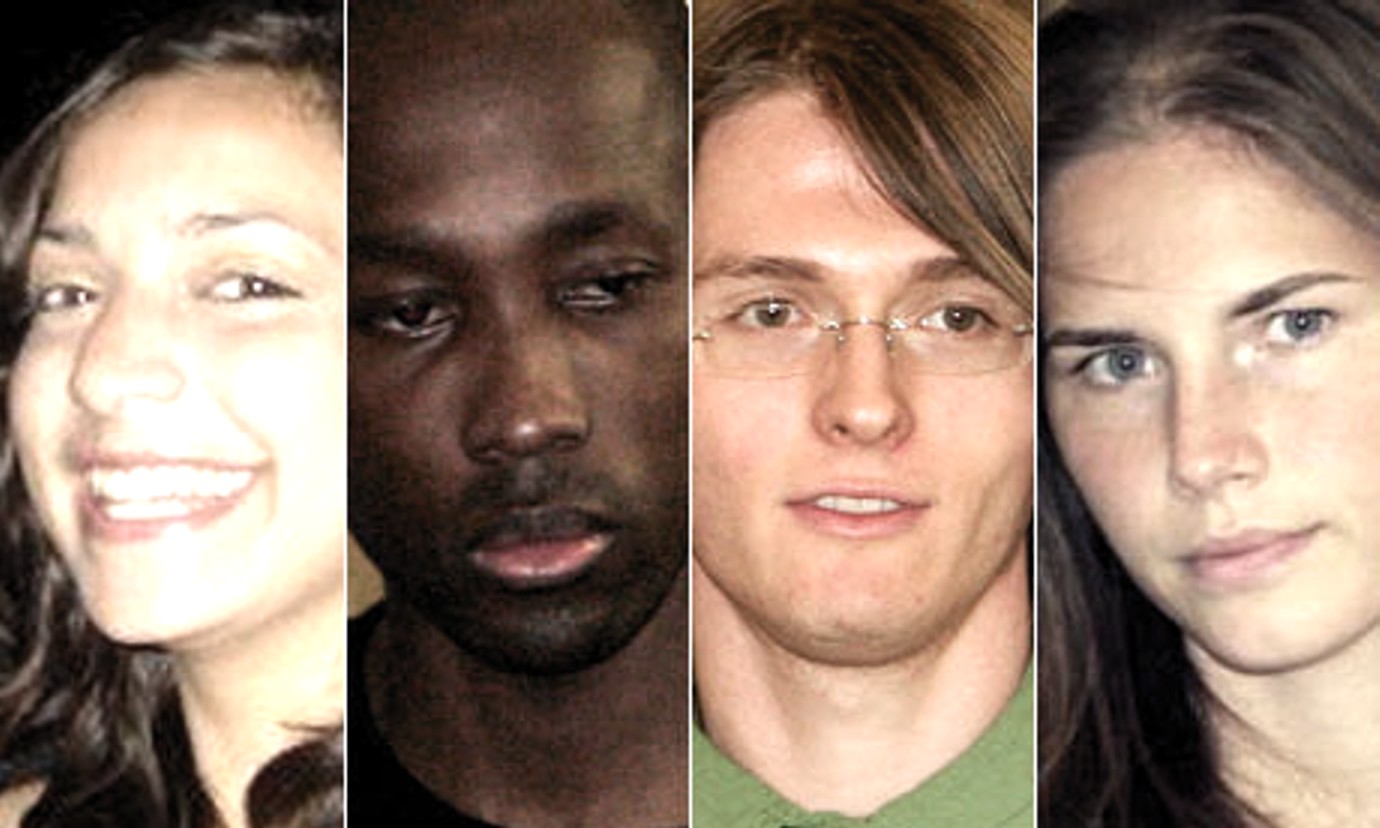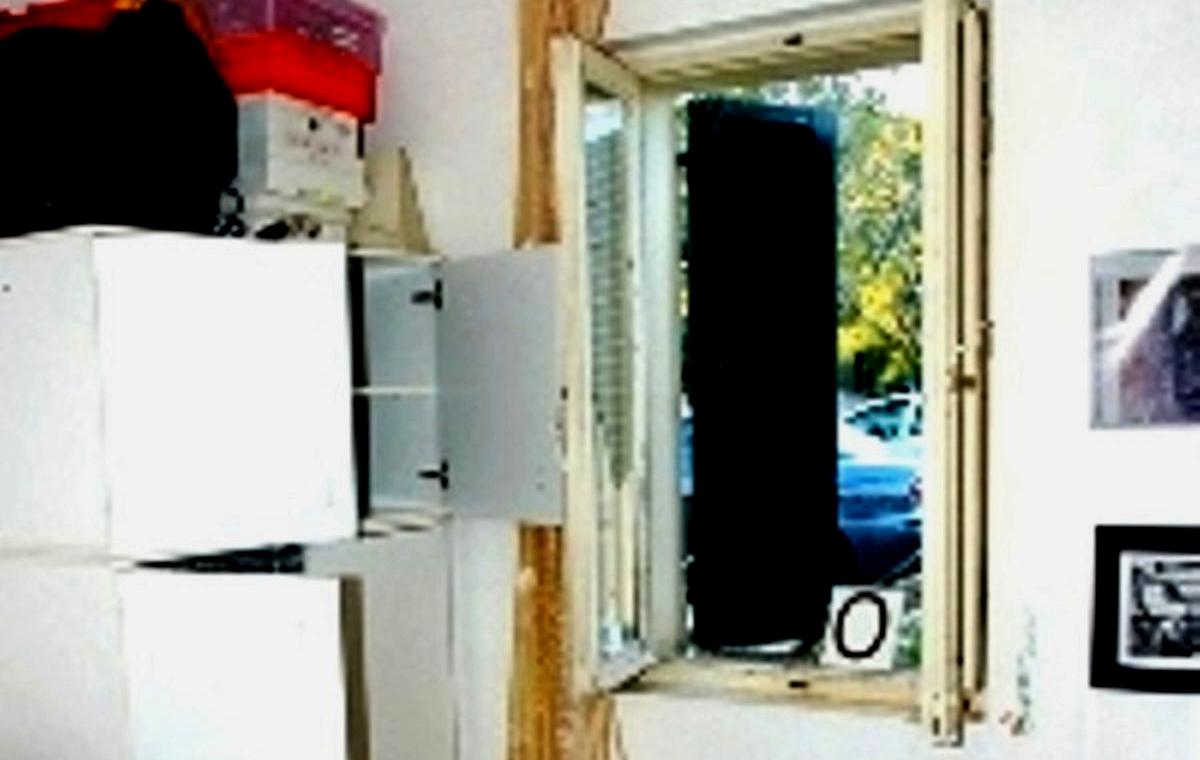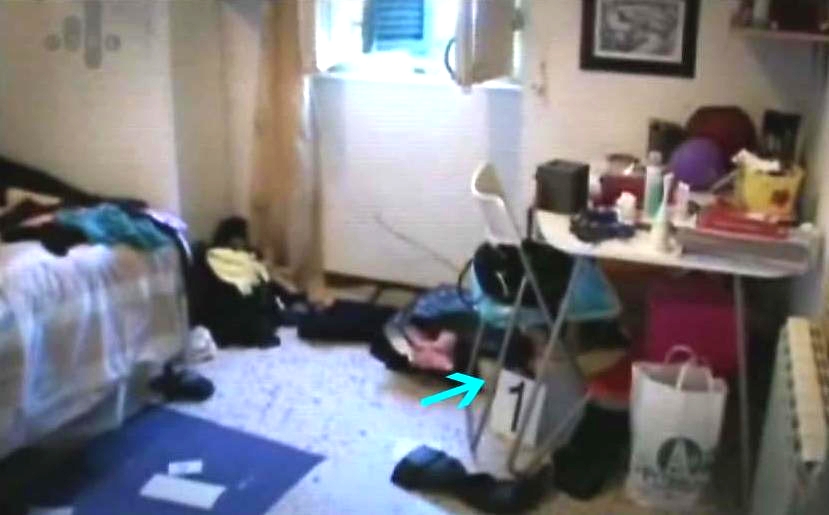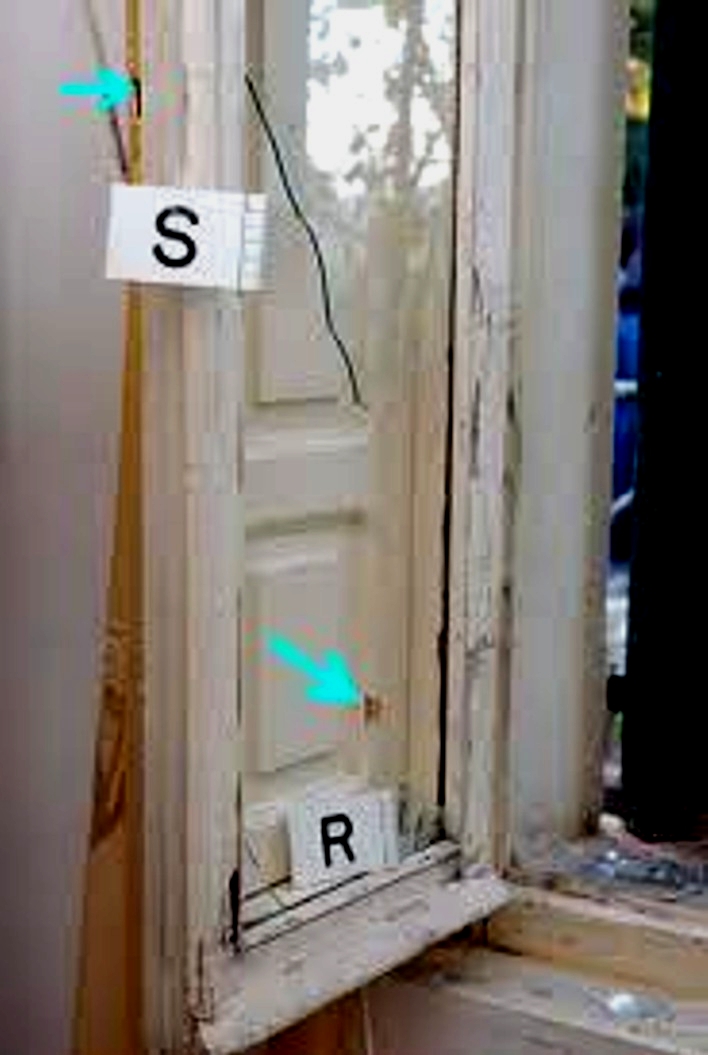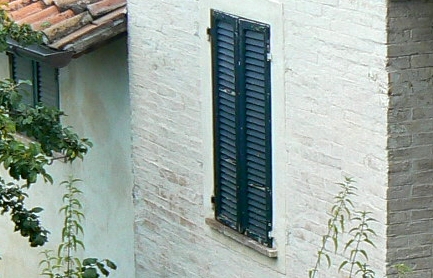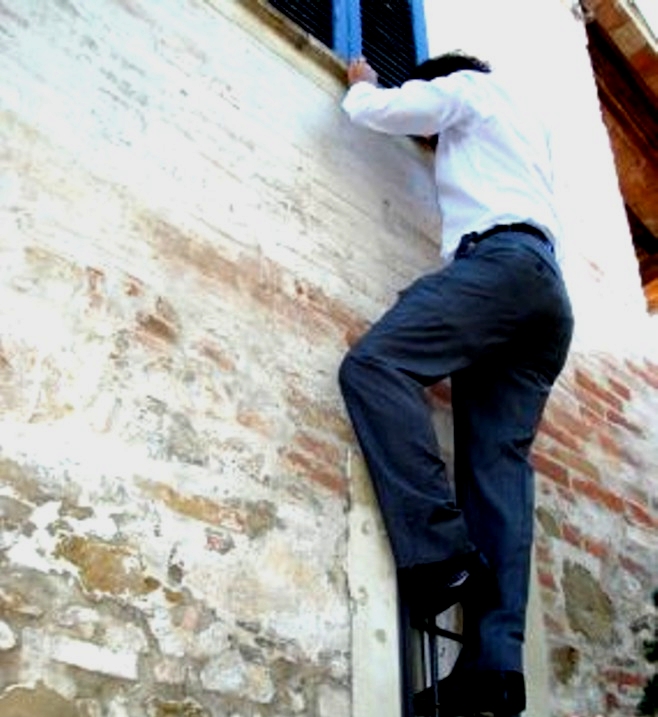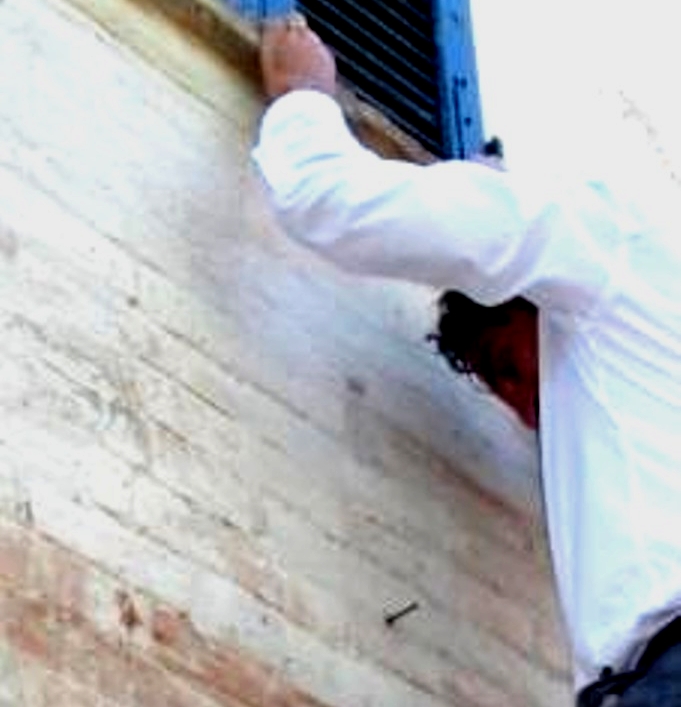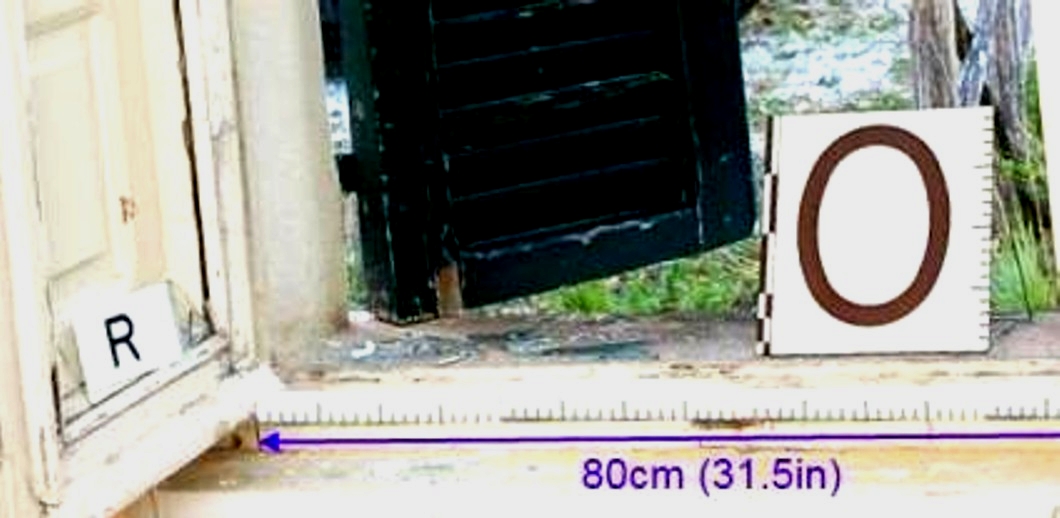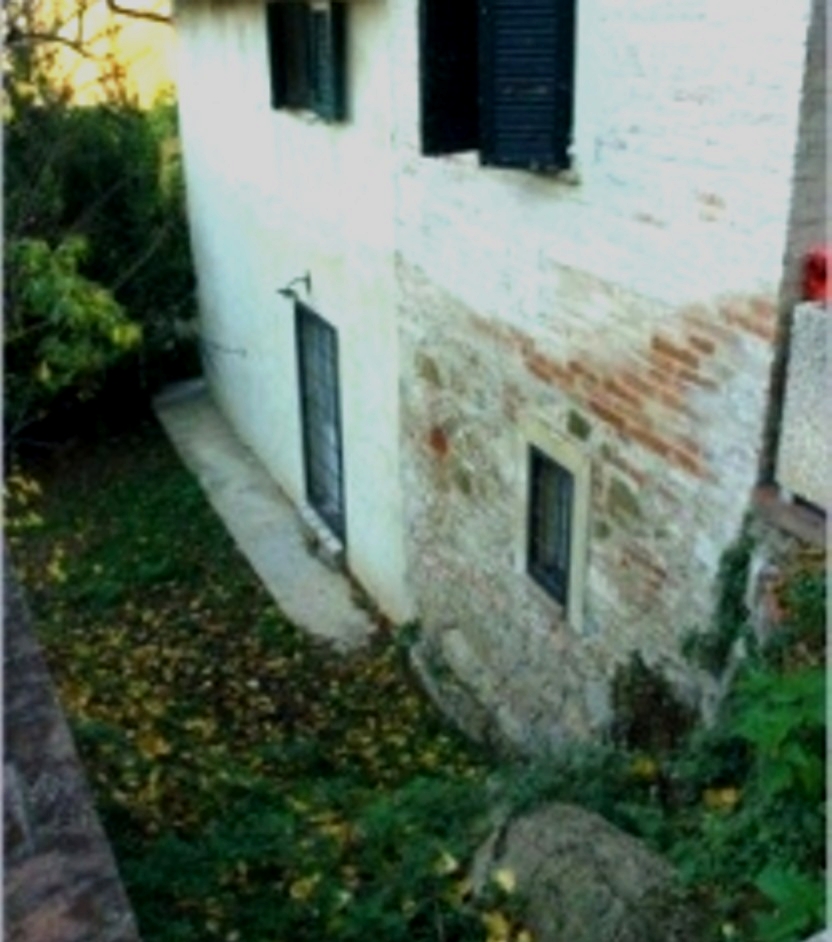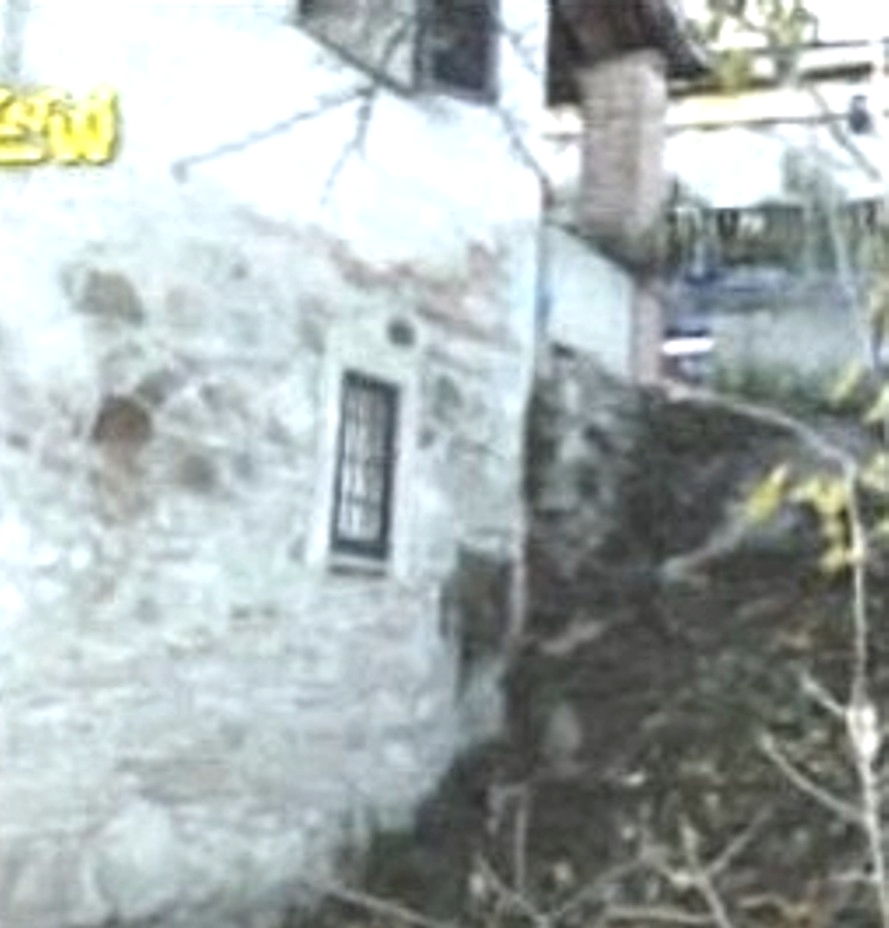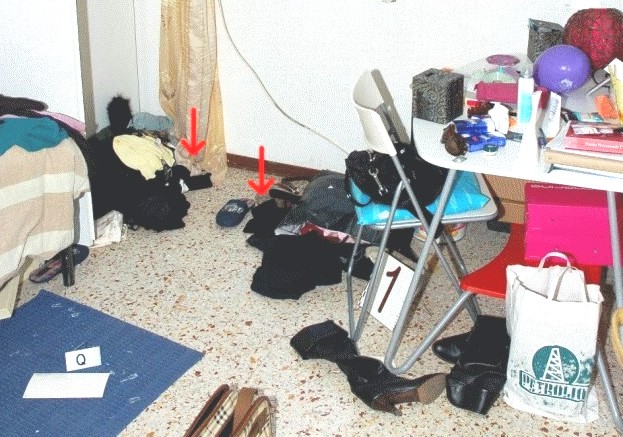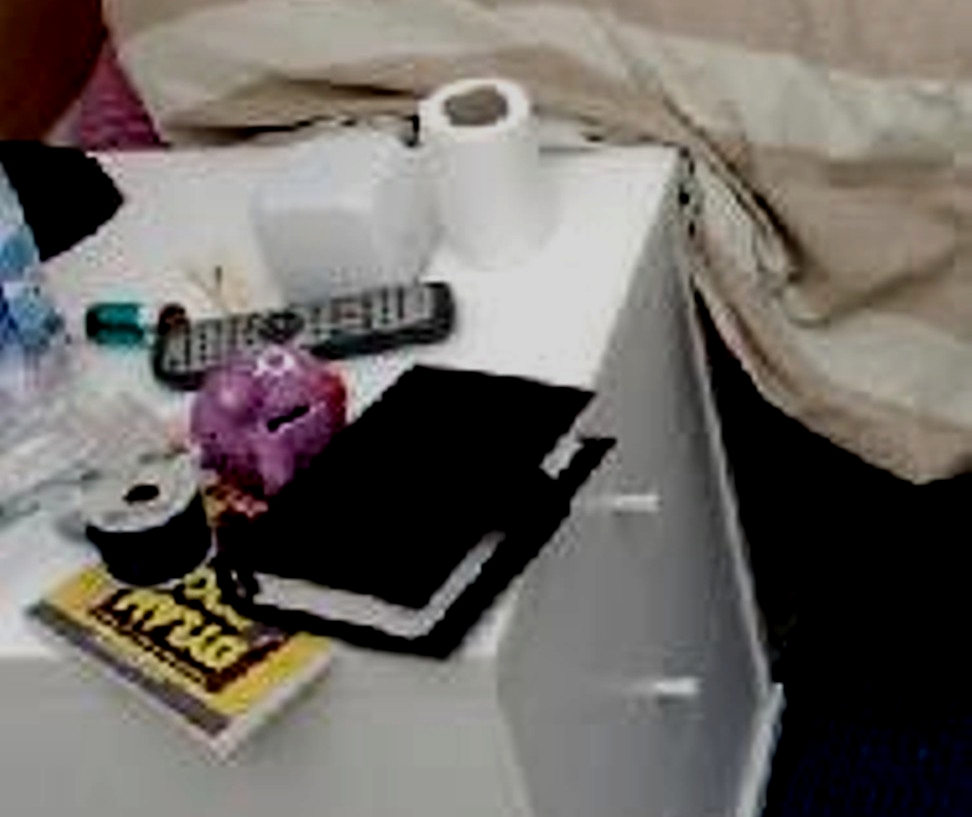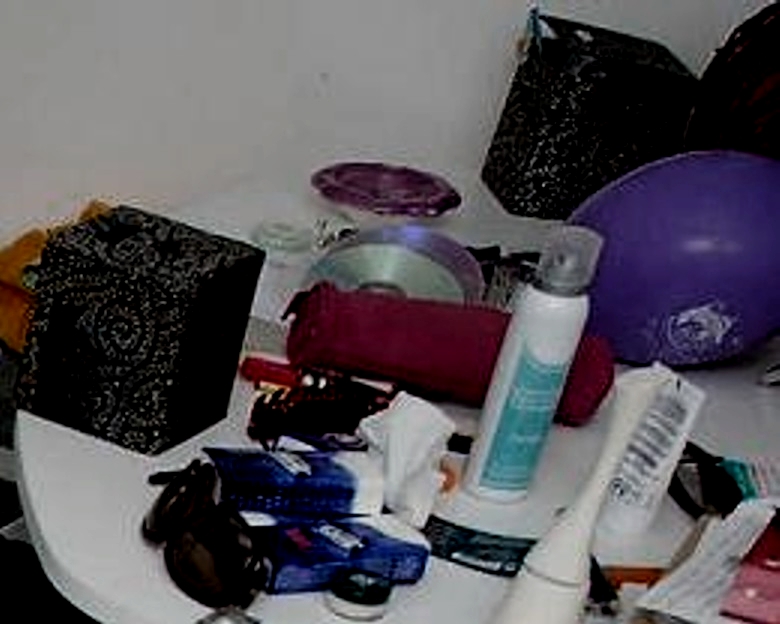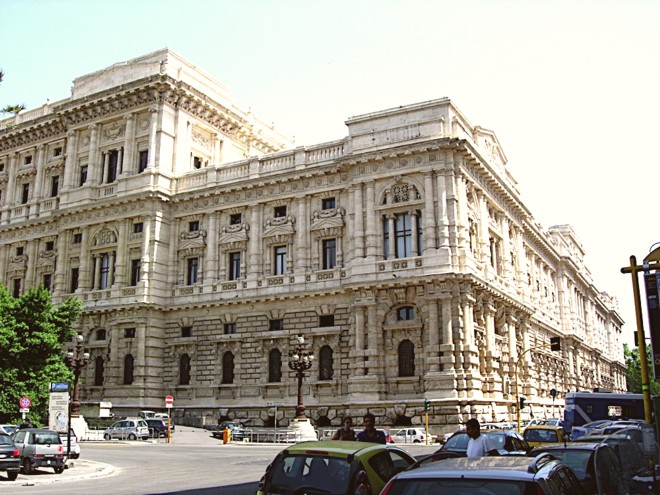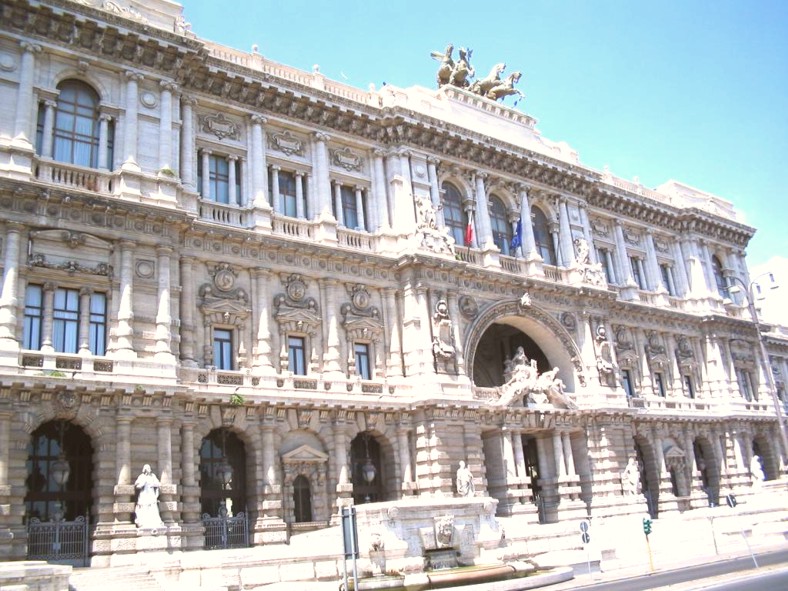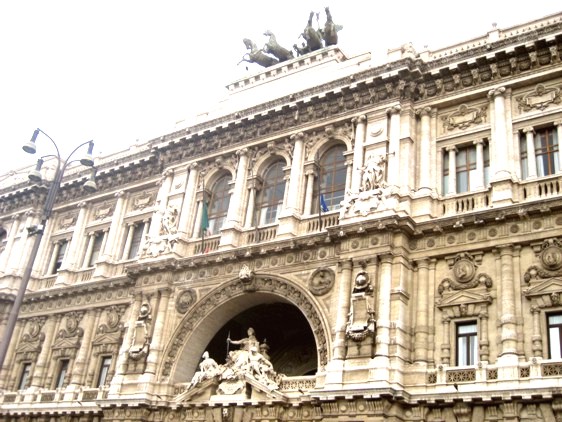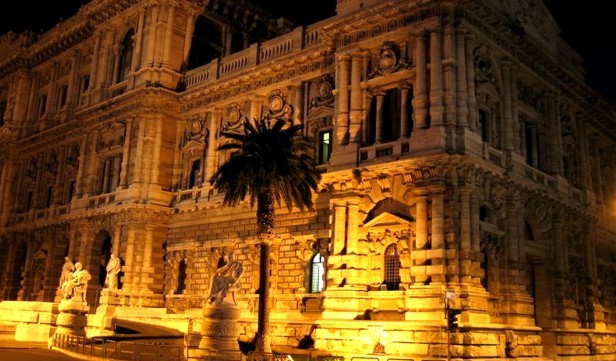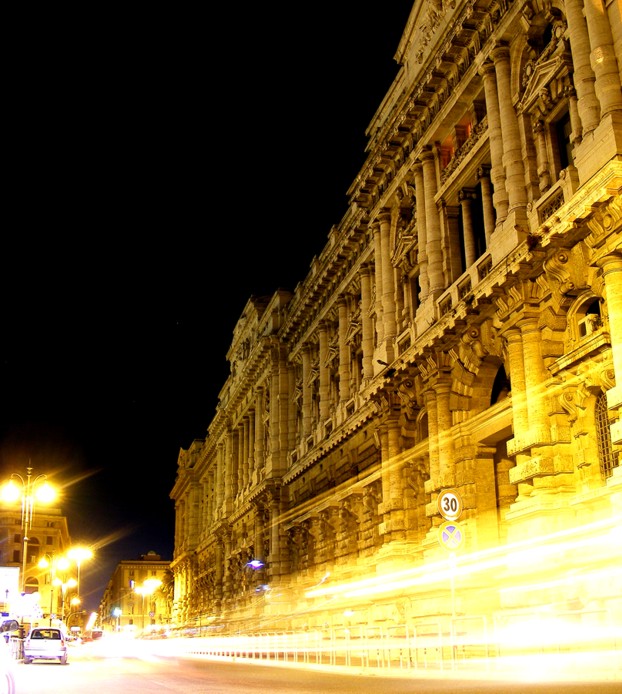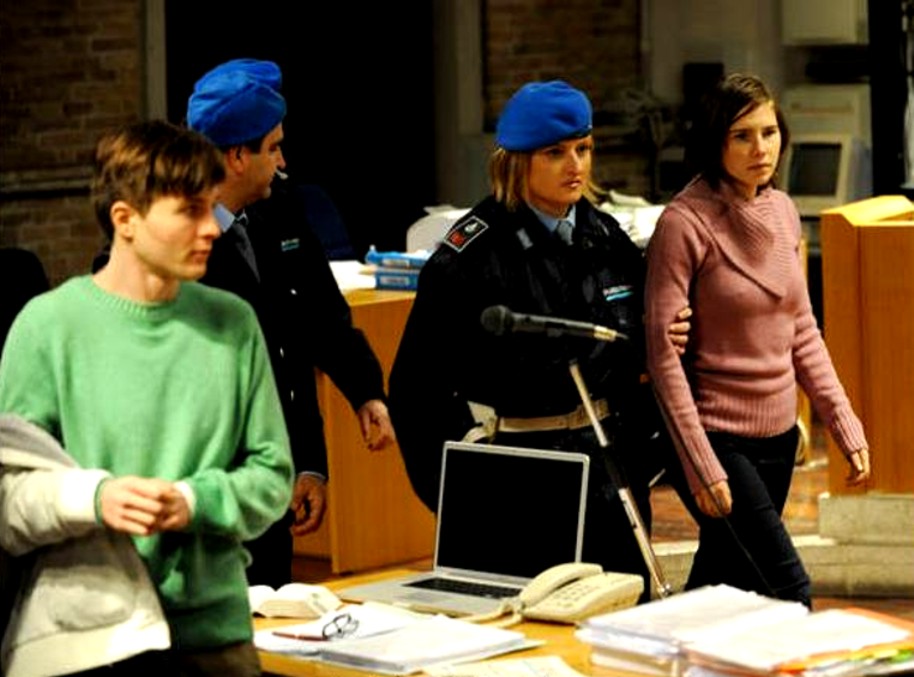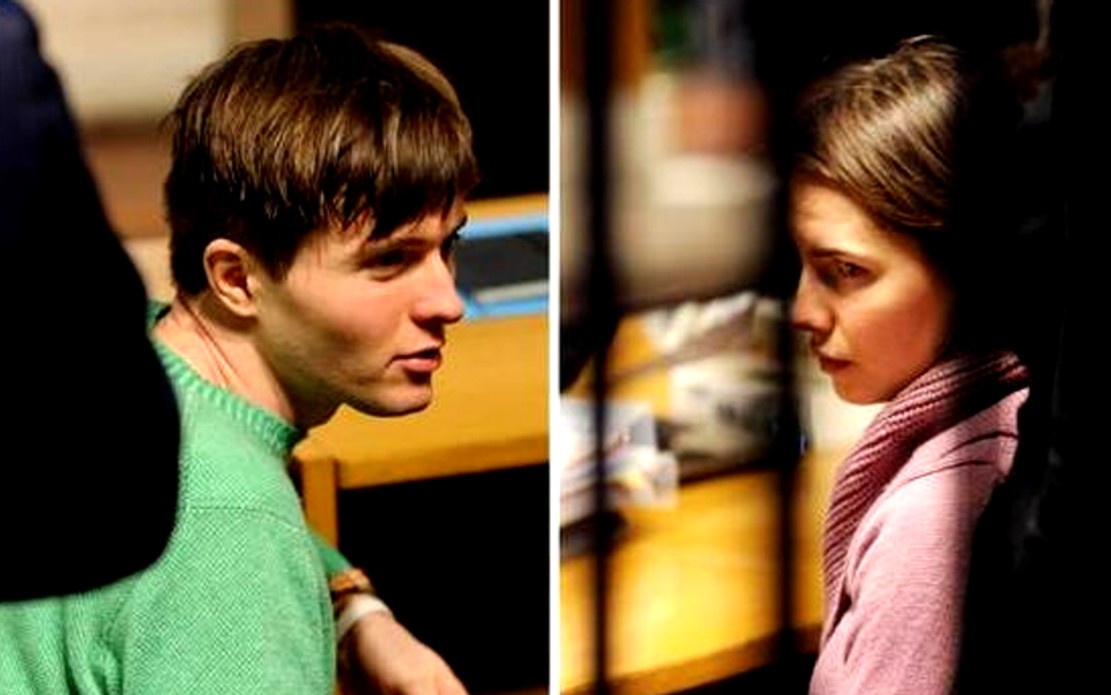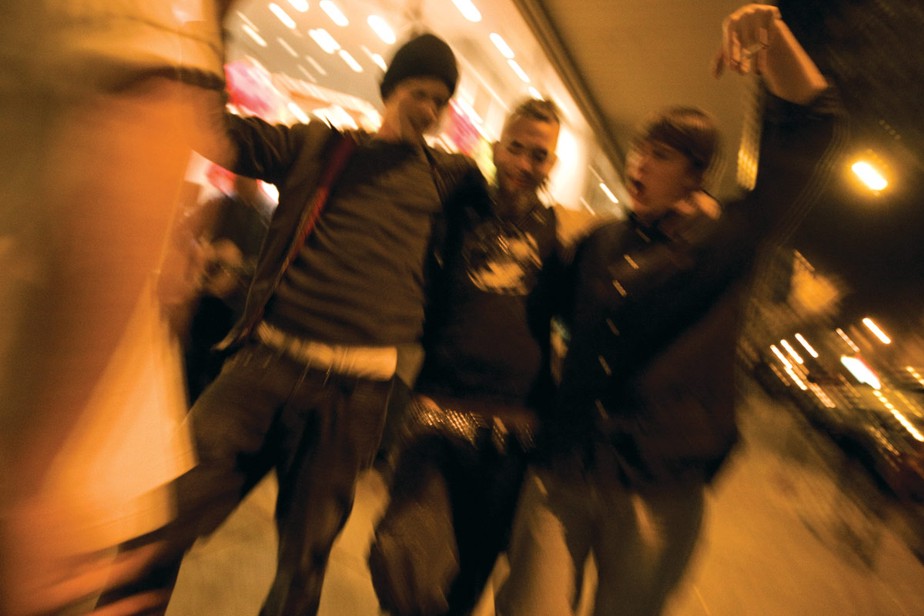
Category: Hoaxes against Italy
Thursday, March 03, 2011
Lifetime’s Misleading Portrayal Of Knox HIV Leak: One Of Many Dishonest Knox-Team Leaks
Posted by Michael
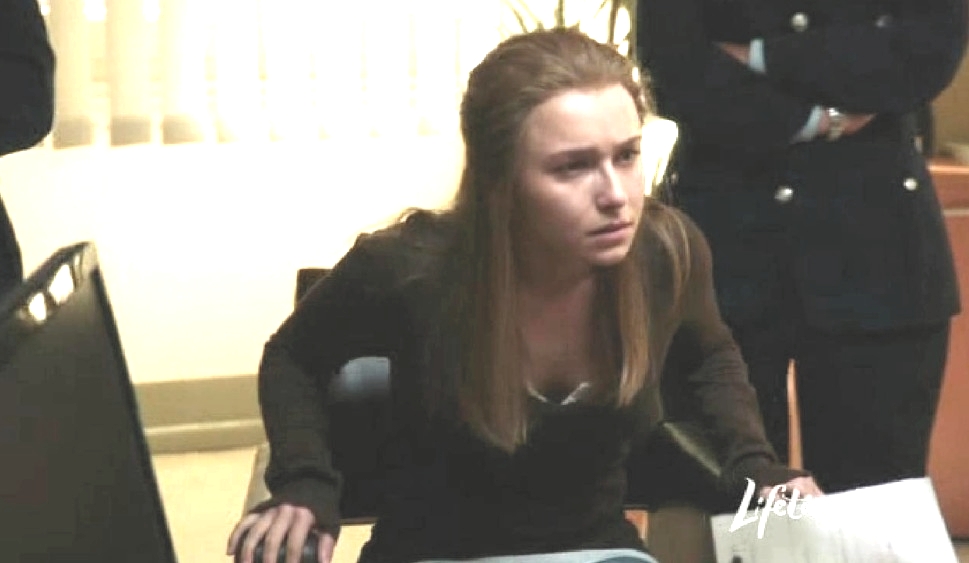
Above and below: images from the two misleading scenes
1. Movie Advances HIV & Sex Partners List Hoax
The Lifetime movie nicely depicted Meredith and Dr Mignini, and was not tough on Knox, though it seemed to leave many viewers sensing the possibility of guilt.
However, there were several seriously wrong scenes in the Lifetime movie, and also in the associated Lifetime documentary. Two scenes advanced the HIV-test and sex-partners-list hoax.
- 1. In a first long and emotional scene, the film depicted Amanda Knox being told by the doctor at Capanne that in a routine test she tested positive for HIV. It implied the test was a form of pressure. It showed Knox being told she should write down a list of her previous partners.
2. In a second long and emotional scene, the film depicted a confrontation between an angry Amanda and the doctor when he told her she was all clear. And thereafter depicted that it was the the prosecution that leaked the sex partners list.
These implied criminal actions on the part of both the Capanne Prison medical staff and the prosecutors, and aroused a lot of false sympathy for Knox.
2. The Hard Facts About Knox’s HIV Testing
1. Lifetime V Reality: Knox Had Herpes When She Was Tested
Lifetime simply depicted Amanda Knox being told by the doctor at Capanne that she tested positive for HIV. It implied the test was unusual.
In fact, on her admittance to Capanne Prison, Knox was simply routinely tested for HIV and some other possible conditions, as all prisoners are, for their own good.
Knox had herpes at the time, visible on her lip in many photographs, and herpes can result in a false positive result for HIV.
2. Lifetime V Reality: Proof Knox Warned Positive Test Maybe False
Lifetime did not depict Knox being warned about false positives. But Knox’s diary reads:
Last night before I went to bed I was taken down to see yet another doctor who I haven’t yet met before. He had my results from a test they took which says I’m positive for HIV.
First of all the guy told me not to worry, it could be a mistake, they’re going to take a second test next week….
3. Lifetime V Reality: Knox Herself Creates Sex Partners List
Lifetime claimed Amanda Knox was told to write down her list of partners by the doctor.
But in Amanda Knox’s own words, you can read how it went down: She chose herself to create the sex partners list. The doctor never instructed Amanda to write out that list. Her diary reads:
Thirdly, I don’t know where I could have got HIV from. Here is the list of people I’ve had sex with in Italy [strike Italy] general:...
4. Lifetime V Reality: There Was No Angry Confrontation
Lifetime depicts a yelling, pointing Knox, who has to be restrained.
The doctor merely conveyed the news of a negative results and Knox cheerfully went off. He had no ill intent, she did not get angry, and no accusations were made.
3. The Hard Facts About Who Leaked The Results & List
Lifetime implied that Knox’s diary with the list of partners was leaked by the prosecutors to the public.
We know this to be false. We know that it was instead Amanda Knox’s own lawyers that leaked the diary with the sex partners list (to journalists like Barbie Nadeau). And that the family effort leaked it to people like Frank Sforza (who duly published Amanda’s diary page on the previous sexual partners), and Candace Dempsey, and even tried to leak it to us!
Amanda’s lawyers leak like sieves, always have, and they’ve rarely, if ever, asked Amanda permission to do so. It isn’t actually required, since she’s already given them permission to act on her behalf. In a way, it’s a bit like electing a politician. Once you’ve elected them, they don’t have to come back to you (the electorate) for permission every time they want to pass a bill, create a new policy or enter into negotiations.
When we had our own reporter (Stewart Home) attending the trial, the defence happily showed him anything in the case file he asked to see. In fact, many times they offered without his having to even ask.
In addition, Amanda’s family have been doing quite a lot of ‘leaking’ themselves. Frank Sforza and Candace Dempsey got most of their data from them, as did Charlie Wilkes, Mark Waterbury and Bruce Fischer. And this leaking by the family started long before the trial.
It needs to also be pointed out, Sollecito’s family and lawyers have also been doing their share of leaking.
However, the Knox family and their followers have been only too happy to publicly blame all this leaking on Italian law enforcement (ILE) and cite this as another injustice against their daughter. The US media have been only too happy to carry these accusations, without question. This is how the ILE have been framed and it stinks.
4. Relevant Misleading Scenes In The Lifetime Film
Top and below: the first partly imaginary scene
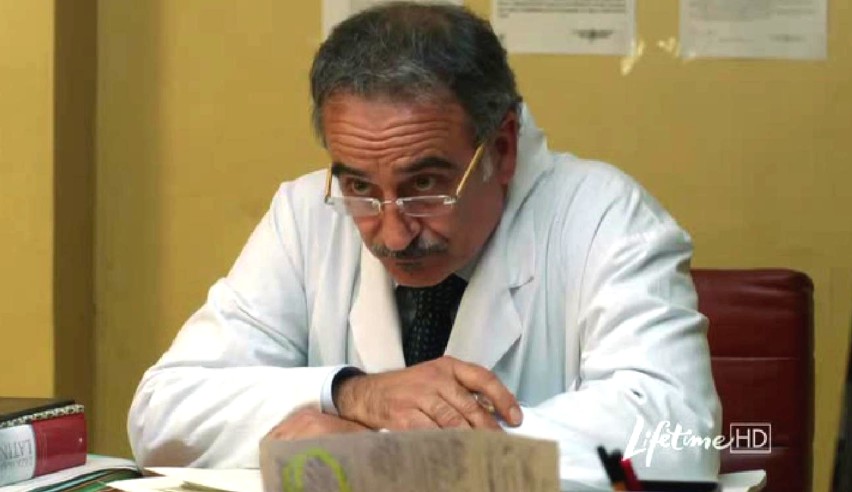
Above and below: the first partly imaginary scene
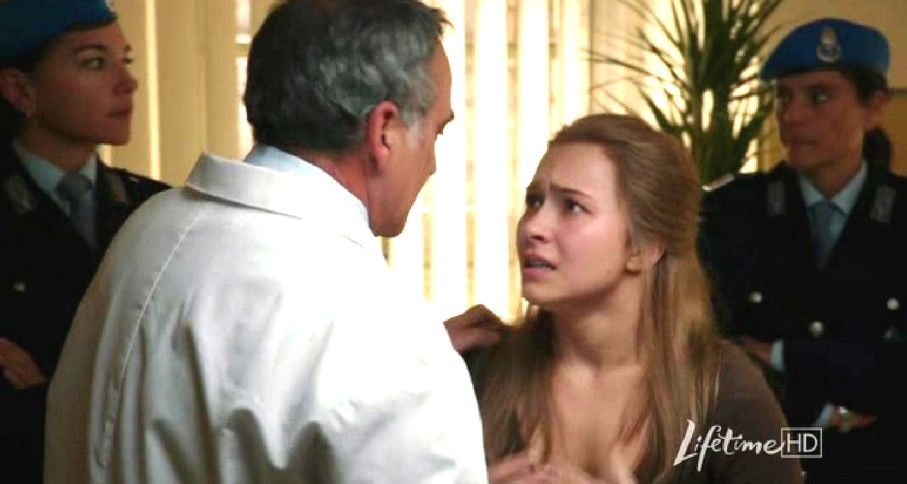
Below: the second very misleading scene
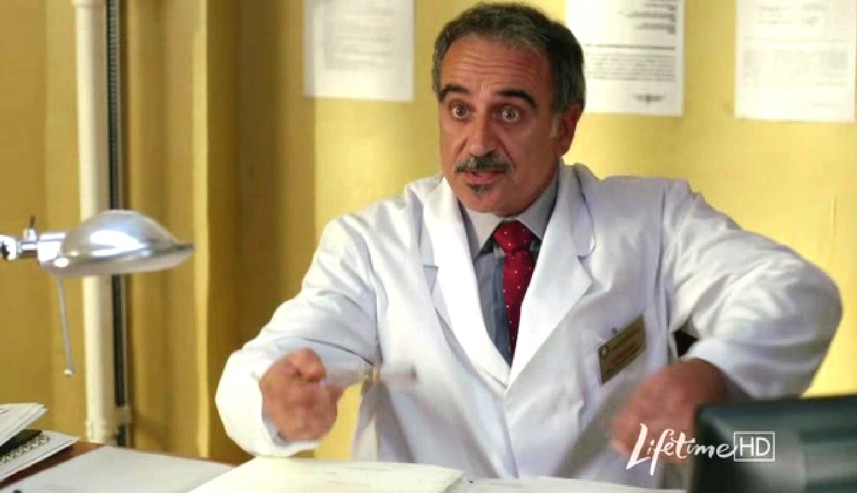
Below: the second very misleading scene
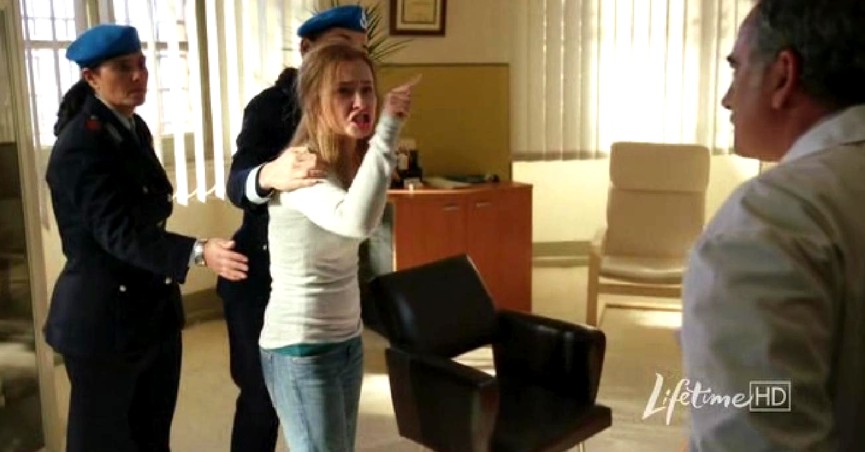
5. Bottom Line: One Of Many Knox-Team Hoaxes
Amanda’ Knoxs family know the truth of this, but have not yet come out and corrected a seriously wrong pervasive impression.
And Lifetime repeated the lie of the sex partners list, leading millions to believe the ILE deliberately terrified, tricked and humiliated Amanda Knox.
Saturday, February 26, 2011
Very Hard Language Of Supreme Court In Rejecting Guede Appeal, Confirming Three Did It
Posted by Peter Quennell
The report of the Supreme Court of Cassation released on Thursday was foreshadowed in content in our post of 17 December:
Rudy Guede’s appeal is rejected on all ten grounds. His appeal grounds were ugly and dishonest and he has no further appeal. He will serve his 16 years, with maybe some time off, for being a savage willing party to the cruel stupid murder of Meredith.
Rudy Guede will go down in infamy for his sex crime against a defenseless victim, for being a party to a taunting torturing knife attack, for claiming Meredith invited him in for consensual sex, and for not calling for help for Meredith and maybe saving her life while it was still possible.
Cassation continues the fine Italian court tradition in this case of taking a firm and unblinking position, and for being utterly oblivious to the vile over-the-top campaign of Curt Knox, Edda Mellas and David Marriott which may now haunt Amanda Knox all of her life.
What really caught the Italian media’s attention and made this the second most widely reported development in the case after the Amanda Knox-Raffaele Sollecito verdict was the icy hard language, the pure contempt for the depraved pack attack, the total rejection of all Guede’s stories, including his oft-repeated and totally unbelievable claim that Meredith invited him in and wanted love-making, and the court’s conclusion once again that the evidence methodically described in the Micheli Report overwhelmingly proves that THREE perpetrators took part in the crime.
The Court of Cassation in this report made clear that Knox and Sollecito are not already formally nominated as the other two perpetrators and it does wait the referral of the outcome of the present appeal in Perugia. But unless the defense witnesses Alessi and Aviello can indeed convince Judge Hellman’s appeal court that Guede attacked Meredith with friends or that some other people entirely carried out the attack, there seems no way out for them.
The court also indicated that it considered the motive of the attack on Meredith to be frivolous, which is precisely what the prosecution claims in the current Perugia appeal as grounds for rejecting Massei’s mitigating circumstances, and for increasing Knox’s and Sollecito’s prison sentences to life terms.
This post of a month ago further explains Knox’s and Sollecito’s almost insurmountable problems.
The written report from Cassation on that December 2010 decision on Guede’s final appeal (due soon), plus Judge Micheli’s Sentencing Report for Rudy Guede of January 2009, plus all that associated evidence, now gets automatically ported by law straight into Knox’s and Sollecito’s appeal.
Judge Micheli took a hard line toward Rudy Guede, and he sentenced him to 30 years. He also remanded Knox and Sollecito to trial, and his report explains the basis for that remand.
Judge Micheli’s remorseless and tightly argued report (see summaries below) very comprehensively backed up his decisions. (Later reductions in sentence were automatic and they flowed from the terms of Guede’s short-form trial, and some controversial mitigating circumstances advanced by Massei for Knox and Sollecito.)
The prosecution’s appeal against the Knox and Sollecito sentences argues that the acceptance of mitigating circumstances by the Massei court should be thrown out, and that Knox and Sollecito should be subjected to a longer sentence. Remember that even in the case of Alessi’s wife, who was not even present when he beat the kidnapped baby to death, she received a sentence of 30 years.
So here is how it is stacking up:.
For the prosecution, four courts including the Supreme Court of Cassation have ruled that three people participated in the crime against Meredith, plus all of the evidence from both the Guede and Knox Sollecito trials now comes in, plus the prosecution is appealing for tougher sentences, which seems well justified based on precedents.
And for the defenses? Will they now feel they have no choice but to put Knox or Sollecito or Alessi or Aviello or for that matter Rudy Guede on the stand as a last-ditch manoeuvre?
Hard to see what further they have to lose.
Thursday, February 10, 2011
Report Of The Decay Of The Hard Pro-Knox Party Line In West Seattle
Posted by Peter Quennell
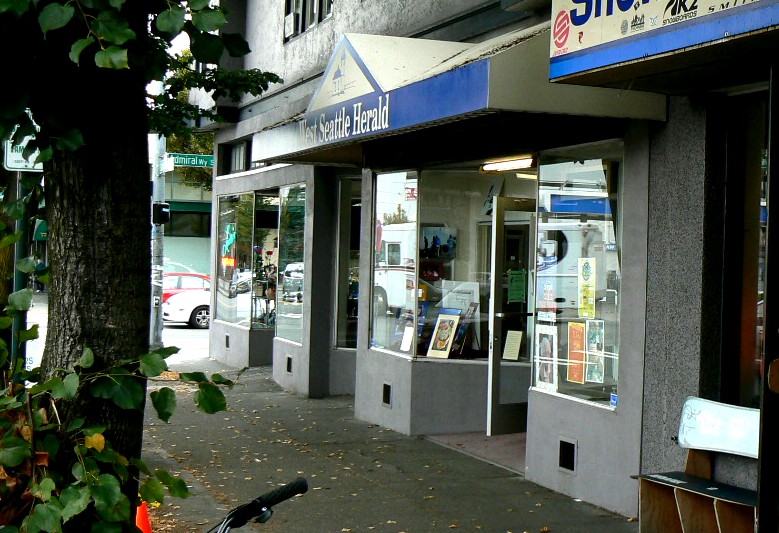
Former HQ of West Seattle Herald
West Seattle Groupthink Under Strong Fire
The Seattle Salmon reports with some amusement on how the residents are increasingly speaking out.
They whisper at the local library branch, nod to each other in line at the Morgan Junction Starbucks, and even occasionally email their true feelings to each other. What is this secret society? It’s not the Masons, Scientologists or even the wily Northwestern Republicans.
No, this fearful group is West Seattleites who think Amanda Knox did it. By “it,” they are referring to the 2007 murder in Italy of which she was convicted. Knox was raised in West Seattle and the community has rallied around her claim of innocence with a fervor that straddles the militant/cult divide.
But some in the community are not so sure and not so talkative about their doubt. One resident who demanded anonymity told the Seattle Salmon, “It’s like a police state out here. You have to go to the legal defense fundraisers ““ like six last year ““ or else you are ostracized at the Westcrest Off-leash area.”
Another said, “The groupthink is terrifying. You step outside of it and you’re like the stupid Regular Seattleite who jaywalks through the all-way crosswalk at The Junction ““ you’re all alone and danger could come at you from any direction. Plus they’d light your ass up on the West Seattle Blog. You’d have to move.”
Perhaps no surprises there. It has been a long time since pro-Steve-Shay comments on the West Seattle Herald have been in the majority. Yesterday he made this ludicrous claim.
Meredith’s father, John, who believes Knox is guilty and has a lawyer in the courtroom fighting to insure she and her boyfriend Raffaele Sollecito remain in jail.
These were the first two responses.
John Kercher’s lawyer is not ‘fighting’ anyone or anything. He has a legal duty to provide representation at the automatic appeal which Italy’s very liberal criminal justice system provides to all convicted criminals.
Your inflammatory, arrogant coverage of this legal process stinks. The US State Department doesn’t think there was anything wrong with the year-long legal process which convicted Knox and Sollecito of torture and murder, and neither do their victim’s family. Again, this doesn’t mean they are ‘fighting’, so grow up.
Mr. Shay atypically made only one glaring distortion in this article; The Kercher family lawyer is involved in the appeals process not to insure that Ms. Knox stay in jail, but rather to make sure the prosecution’s case is presented fairly and objectively, as was certainly done in the court’s verdict.
Not to make the lawyer sound one sided and intent on a path; there are way too many like Shay in the pro innocent Knox camp; this population has been known to lie and distort facts so as to exculpate their darling “West Seattle bred” Knox.
Nice work West Seattle.
Tuesday, February 01, 2011
Explaining The Massei Report: A Visual Guide To The Faked Break-In Via Filomena’s Window
Posted by pat az
1. Post Overview
Cross-posted from my own website on Meredith’s case at the kind invitation of TJMK.
The Massei Report on the trial and sentencing of Amanda Knox and Raffaele Sollecito looks into whether or not a break-in is supported by the evidence available in the room with the broken window.
It concludes that the broken window and room in disarray - Filomena’s bedroom - are an “artificial representation”, ie. that the break-in was faked. After seven pages of review of the evidence, the Massei Report states:
“the situation of disorder in Romanelli’s room and the breaking of the window pane constitute an artificial representation created in order to orient the investigations towards a person who, not having the key to the front door, was supposed to have entered through the previously broken window and then effected the violent acts on Meredith which caused her death.
What follows is a look at the comments in the Massei report compared with crime scene and other photos. All quotes are from the English translation prepared by unpaid volunteers at PerugiaMurderFile.org. The section on the scenes in the bedroom begins on page 47 and continues to page 55. Some sentences in the paragraphs below have been omitted for brevity, and can be read in full in the original.
2. Knox Finds The Scene
Then (Amanda) went into another room and noticed that the window had been broken and that there was glass inside. She told these things to her and the other girls present. Then she related that she had gone back to Raffaele’s house and had rung Filomena.
I)n one of the telephone calls to Romanelli, Amanda spoke of that smashed window and of the possibility that someone could have entered the house through the broken place; she said this also in the telephone call to 112 and in the first declarations to the Postal Police.
Also in the e-mail of November 4, 2007, sent by Amanda to 25 people in the US, she hypothesises that a burglar could have entered the house and says she looked around to see if anything was missing.
Filomena Romanelli, disturbed by this phone call, had rung Amanda back without receiving a reply and when, a little later, she had succeeded in speaking to Amanda, Amanda had told her that in her room (i.e., in Ms. Romanelli’s room) the windowpane was broken, everything was in a mess, and that she should come back home.
Filomena Romanelli had ascertained from a quick check of her room, even though (it was) in a complete mess with the windowpane broken, that nothing was missing.
It must be held that when Filomena Romanelli left the house in via della Pergola, she had pulled the [interior] shutters towards the interior of her room, although she did not think that she had actually closed them; furthermore, because they were old and the wood had swelled a bit, they rubbed on the windowsill; to pull them towards the room it was necessary to use some force (“they rubbed on the windowsill”); but in this way, once they had been pulled in, as Romanelli remembered doing, they remained well closed by the pressure of the swelled wood against the windowsill.
It cannot be assumed - as the Defence Consultant did - that the [interior] shutters were left completely open, since this contradicts the declarations of Romanelli, which appear to be detailed and entirely likely, considering that she was actually leaving for the holiday and had some things of value in her room; already she did not feel quite safe because window-frames were in wood without any grille.
Also, the circumstance of the [interior] shutters being wide open does not correspond to their position when they were found and described by witnesses on November 2, and photographed (cf. photo 11 already mentioned).
Now, for a rock to have been able to break the glass of the window without shattering the outside shutters, it would have been necessary to remove the obstacle of the shutters by opening them up.
Consequently, since the shutters had been pulled together and their rubbing put pressure on the windowsill on which they rested, it would have first been necessary to effect an operation with the specific goal of completely opening these shutters.
The failure to find any instrument suitable for making such an opening (one cannot even see what type of instrument could be used to this end) leads one to assume that the wall would have to have been scaled a first time in order to effect the complete opening of the shutters, in order to enable the burglar to aim at the window and smash it by throwing a large stone - the one found in Romanelli’s room.
He would then have to have returned underneath Romanelli’s window for the second climb, and through the broken glass, open the window (balanced on his knees or feet on the outside part of the windowsill), otherwise he would not have been able to pass his arm through the hole in the glass made by the stone) and reach up to the latch that fastened the window casements, necessarily latched since otherwise, if the casements had not been latched, it would not have been necessary to throw a rock at all, but just to open the shutters and climb inside.
The “climber” would also need to rely on the fact that the [interior] shutters were not actually latched, and also that the “scuri” ]blackout blind] had not been fastened to the window-frame to which the broken pane was attached; otherwise it would not have been possible to open them from the outside; nor would it have been possible, even breaking the glass, to make a hole giving access to the house, since if these inner panels had been closed, they would have continued to provide an adequate obstacle to the possibility of opening the window, in spite of the broken pane.
This scenario appears totally unlikely, given the effort involved (going twice underneath the window, going up to throw the stone, scaling the wall twice) and taking into account the uncertainty of success (having to count on the two favourable circumstances indicated above), with a repetition of movements and behaviours, all of which could easily be seen by anyone who happened to be passing by on the street or actually coming into the house.
But beyond these considerations, there are other elements which tend to exclude the possibility that a burglar could have entered the house through the window of Romanelli’s room.The double climb necessary to attain the height of three and a half metres would have left some kind of trace or imprint on the wall, especially on the points on the wall that the “climber” would have used to support his feet, all the more as both the witnesses Romanelli and Marco Zaroli gave statements indicating that the earth, on that early November evening, must have been very wet (..6) (p50)
In fact, there are no visible signs on the wall, and furthermore, it can be observed that the nail ““ this was noted by this Court of Assizes during the inspection ““ remained where it was: it seems very unlikely that the climber, given the position of that nail and its characteristics, visible in the photo 11, did not somehow “encounter” that nail and force it, inadvertently or by using it as a foothold, causing it to fall or at least bend it. (p50)
The next fact to consider is that the pieces of glass from the broken pane were distributed in a homogeneous manner on the inside and outside parts of the windowsill, without any displacement being noted or any piece of glass being found on the ground underneath the window.
This circumstance, as confirmed also by the consultant Pasquali, tends to exclude the possibility that the rock was thrown from outside the house to create access to the house through the window after the breaking of the pane. The climber, in leaning his hands and then his feet or knees on the windowsill, would have caused at least some piece of glass to fall, or at least would have been obliged to shift some pieces of glass in order to avoid being wounded by them.
Instead, no piece of glass was found under the window, and no sign of any wound was seen on the pieces of glass found in Romanelli’s room. It can moreover be observed that the presence of many pieces of glass on the outside part of the windowsill increases the probability of finding some small pieces of glass on the ground underneath, since there seems to be no reason that so many pieces of glass would all stop just at the edge of the windowsill without any of them flying beyond the edge and falling down to the garden below. (p51 & 52)
On this subject it is also useful to recall that at the hearing of April 23, 2009, the witness Gioia Brocci mentioned above declared that she had observed the exterior of the house, paying particular attention to the wall underneath the window with the broken pane, the window of the room then occupied by Filomena Romanelli.
She said: “We observed both the wall”¦underneath the window and all of the vegetation underneath the window, and we noted that there were no traces on the wall, no traces of earth, of grass, nothing, no streaks, nothing at all, and none [39] of the vegetation underneath the window appeared to have been trampled; nothing” (p. 142 declarations of Gioia Brocci). (51)
This situation, like all the other glaring inconsistencies, is adequately and satisfactorily explained if one supposes that the rock was thrown from the inside of the room, with the two shutters pulled inwards so that they blocked the pieces of glass from falling to the ground below. Once the glass had been broken from inside, the rock was set down at some place in the room, and the shutters were pushed towards the outside, being thus opened from within the room. (p51)
But the fact that all this was in fact just a simulation, a staging, can be deduced from further circumstances. From the photos taken by the personnel of the Questura (photos 47 to 54 and 65 to 66) one can perceive an activity which appears to have been performed with the goal of creating a situation of obvious disorder in Romanelli’s room, but does not appear to be the result of actual ransacking, true searching for the kind of valuable objects that might tempt a burglar.
The drawers of the little dresser next to the bed were not even opened (photo 51 and declarations of Battistelli who noted that Romanelli was the one who opened the drawers, having found them closed and with no sign of having been rifled: see p. 66 of Battistelli’s declarations, hearing of Feb. 6, 2009).
The objects on the shelves in photo 52 appear not to have been touched at all; piles of clothes seem to have been thrown down from the closet (photo 54) but it does not seem that there was any serious search in the closet, in which some clothes and some boxes remained in place without showing any signs of an actual search for valuable items that might have been there (photo 54).
It does not appear that the boxes on the table were opened (photo 65) in a search for valuable items. And indeed, no valuable item (cf. declarations of Romanelli) was taken, or even set aside to be taken, by the ““ at this point we can say phantom ““ burglar.
What has been explained up to now thus leads to the assertion that the situation of disorder in Romanelli’s room and the breaking of the window pane constitute an artificial representation created in order to orient the investigations towards a person who, not having the key to the front door, was supposed to have entered through the previously broken window and then effected the violent acts on Meredith which caused her death.
Footnotes
(...1) The Massei Report in English is readable and downloadable via the link at the top of this page.
(..2) The consultant for the defence actually assumed that this had been done; in his exhibit, he assumed that the shutters were not present in front of the window
(..3): “if the shutters were closed, he could not have passed through, that is obvious”, cf. declarations of the consultant for the defence, Sergeant Francesco Pasquali, p. 22 hearing July 3, 2009.
(..4): (the window in Romanelli’s room is located at a height of more than three and a half metres from the ground underneath, cf. photo 11 from the relevant dossier)
(..5):,which are the wooden panels [scuri=non-louvered shutters in interior of room] that usually constitute the outer side (or the inner, depending on the point of view) of the window [attached to the outer edge of the inner side of the window-frame]
Monday, January 24, 2011
The Limited DNA Reviews - What We Believe Are The Hard Facts On The Double DNA Knife
Posted by ViaDellaPergola
Repeat of my December post as the knife is again back in sharp focus.
The wild claims of the conspiracy theorists have morphed back and forth. But the facts remain that Italy has a fine DNA lab system and Dr Stefanoni is internationally respected - and she had no vested interest in a particular outcome.
Sollecito coolly explained that Meredith’s DNA SHOULD be on the blade of the knife because he pricked her while he was cooking a fish at his place. She had never ever been to his place - in fact, she had only set eyes on him once or twice, very briefly, and had certainly not eaten his fish.
But Sollecito STILL lets that highly incriminating statement stand - one that is enough to secure a conviction in an American court all by itself. Sollecito never retracted or explained it. Why not? Why not?
The truth, obviously, is worse. Very, very much worse.
Thursday, January 20, 2011
The New 80,000 Pound Gorilla In The Room Introduced By The Italian Supreme Court
Posted by Our Main Posters

[St Peter’s and the Vatican in background; Palace of Justice, large white building by river in left foreground]
What is the biggest headache for the defenses?
That their areas of appeal, already circumscribed by Judge Hellman, could all explode in their faces? The low-credibility witnesses Alessi and Aviello? The limited DNA retesting? The re-examination of the witness in the park who had no cause to make anything up?
Or that Rudy Guede gets totally ticked off by Alessi’s claims that Rudy Guede said he did it with one or two others, and so Guede tells the court all that REALLY happened?
No, it looks to us that the defenses’ biggest headache by far is that the court of final appeal in Rome (the Supreme Court of Cassation, which is superior to the Perugia appeals court and will hear the second and final appeal) has ALREADY accepted that Rudy Guede’s sentencing report of January 2009 holds up.
And that all three of them attacked Meredith.
The written report from Cassation on that December 2010 decision on Guede’s final appeal (due soon), plus Judge Micheli’s Sentencing Report for Rudy Guede of January 2009, plus all that associated evidence, now gets automatically ported by law straight into Knox’s and Sollecito’s appeal.
Judge Micheli took a hard line toward Rudy Guede, and he sentenced him to 30 years. He also remanded Knox and Sollecito to trial, and his report explains the basis for that remand.
Judge Micheli’s remorseless and tightly argued report (see summaries below) very comprehensively backed up his decisions. (Later reductions in sentence were automatic and they flowed from the terms of Guede’s short-form trial, and some controversial mitigating circumstances advanced by Massei for Knox and Sollecito.)
The prosecution’s appeal against the Knox and Sollecito sentences argues that the acceptance of mitigating circumstances by the Massei court should be thrown out, and that Knox and Sollecito should be subjected to a longer sentence. Remember that even in the case of Alessi’s wife, who was not even present when he beat the kidnapped baby to death, she received a sentence of 30 years.
So here is how it is stacking up:.
- For the prosecution, four courts including the Supreme Court of Cassation have ruled that three people participated in the crime against Meredith, plus all of the evidence from both the Guede and Knox Sollecito trials now comes in, plus the prosecution is appealing for tougher sentences, which seems well justified based on precedents.
- For the defenses, just those few areas the defenses want to challenge which have been allowed by Judge Hellman NONE of which are sure things.
Really not very much going for the defenses here. No wonder they already seem to be phoning it in.
Our meticulous summaries of the Micheli Report by main posters Brian S and Nicki were based on our own translation. A huge amount of work. They were posted nearly two years ago. Periodically we link to them in other posts or we point to them in an email.
Those who do read those posts fresh are often stunned at their sharpness, and for many or most it becomes case closed and the verdict of guilty is seen as a fair one.
We think those posts on Micheli are so key to a correct grasp of Knox’s and Sollecito’s appeal prospects that they should now be reposted in full.
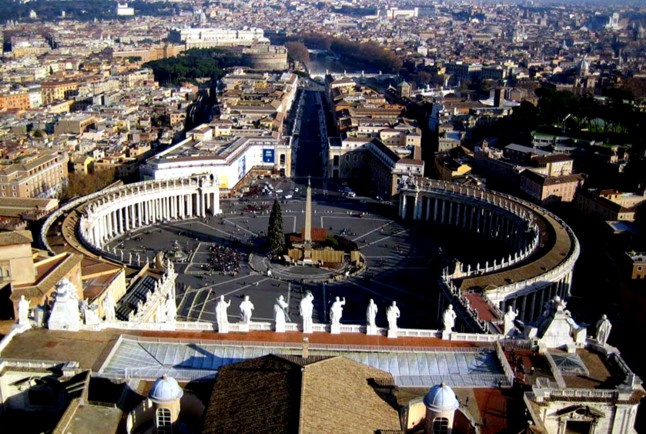
[St Peter’s and the Vatican in foreground; Palace of Justice, large white building in left background]
Understanding Micheli #1: Why He Rejected All Rudy Guede’s Explanations As Fiction
By Brian S
Judge Micheli has had two very important roles. He presided over Rudy Guede’s trial and sentencing, and he presided over the final hearing that committed Raffaele Sollecito and Amanda Knox to trial.
A week ago, just within the three-month deadline, Judge Micheli made public the 106-page report that explains the thinking behind both actions. This is a public document, and in the enviable Italian legitimizing process, the public is encouraged to get and read the report and to understand the full rationales. Excellent analyses have already appeared in Italian in Italy, but no English-speaking sources on the facts of the case have either put the report into English or published more than the most superficial analysis.
These posts will examine several very key areas of the report so that we too may choose whether to buy into the rationales. The translations into English here were by native-Italian speakers and fellow posters Nicki and Catnip. The next post will explain why Micheli ruled out the Lone Wolf Theory, and why he concluded that Knox and Sollecito appeared to be implicated in Meredith’s murder and should therefore be sent to trial.
Judge Micheli maintained that from the moment Meredith’s body was discovered until his arrest in Germany on November 19th, Rudy Guede was in a position to compile a version of his involvement in events at the cottage which would minimise his reponsibilities and point the finger of guilt elsewhere.
He was able to follow the course of the investigation in newspapers and on the internet. He would know of the arrests of Amanda, Raffaele and Patrick. He would know that the investigators had found biological evidence which would sooner or later connect him to the murder, and he would know of other discoveries and evidence which had been publicised in the media.
His story as told in Germany was compiled with all the knowledge about the crime and investigation he would have sought out. On his return to Italy in December he was interviewed by the investigating authorities and gave version 2. He was interviewed again in March which resulted in version 3, and later still made a spontaneous statement to change one or two facts including the admission that the trainer footprint in Meredith’s room could be his. Judge Micheli said:
- Analyzing the narratives of the accused…he is not credible, as I will explain, because his version is (1) unreliable, and (2) continuously varying, whether on basic points or in minor details and outline.
Micheli then examined the details of Rudy’s claimed meeting with Meredith which resulted in his invitation to the cottage on the evening of November 1st.
He noted there were substantial differences between his versions of December and March, particularly with regard to the location of his meeting with Meredith on the night of Halloween and his movements in the early evening of November 1st.
He considered it likely that Rudy had made these changes as he became aware of evidence which contradicted his December version. Notably, in December Rudy claimed to have had his meeting with Meredith which resulted in her invite at a Halloween party given by Spanish students.
By March it was well known that Meredith had spent her entire Halloween in the company of friends, first in the Merlin pub before they later moved on to Domus disco. In March Rudy changed the location of his meeting with her from the Spanish party to Domus, which by chance Rudy had also attended following the party. However, neither Meredith’s friends who were continuously in her company nor those who accompanied Rudy to the Domus witnessed any meeting between the two. Judge Micheli commented:
- On 26 March 2008, instead, Rudy explained to the Prosecution, drawing a picture, that the group invited to the Spaniards’ house actually moved wholus-bolus to the “Domus” club, but it was right in that nightclub that he met Kercher, and not before; offering up a tour-guide description from the chair, saying, “there’s a bar for the drinks and then there’s a room, there’s an arch and a room. I walking [sic] around there, and that’s where I met Meredith”. On the facts of the meeting and the subject of the conversation, he elaborated: “I started talking to Meredith “¦talking anyway I gave her a kiss.. after which I told her how much I liked her and asked her if the next day, in all the confusion anyway, if we were going to meet the next day and she said yes (”¦), we met in the evening around half eight, like that.
While not intending to explore the question, basically irrelevant, of whether the pair had agreed to a more or less specific time (his confirmation of the suggestion of 8.30 pm in both verbal statements however allows the inference that according to Guede they had an appointment), the patent contradiction between the two versions jumps out. One context, of a room between two bathrooms, in an apartment, is completely different to that of a drinks-bar and an arch, in a pub; one might concede, perhaps, the possibility of forgetting which place it was where they last bumped into a friend, but hardly the first time there was a kiss with a girl towards whom one was attracted.
With regard to his movements in the early evening of November 1st, Rudy’s friend Alex failed to corroborate Rudy’s December claim to have visited his flat. He said he didn’t see Rudy either before or after his meeting with Meredith at her cottage.
In March, Rudy changed his story and claimed to have risen at 6pm(following the all-nighter at Domus) before wandering around town for an hour or so. He then said he went to Meredith’s cottage but received no answer so he carried on to Piazza Grimana in the hope he might see people he knew. He thought he arrived in the Piazza at around 7:30pm. He claimed that some time later he left Piazza Grimana and called at the Kebab shop before returning to Meredith’s cottage and arriving some time between 8:30 and 9:00pm.
He said he then waited until her arrival some time just after 9:00pm. It was noted that in both his December and March versions Rudy said he had arranged to meet Meredith at 8:30pm. Micheli noted that this didn’t sit well with another arrangement Rudy had made to meet Carlos (from the Spanish party) between 9:00 and 10:00pm.
Micheli said that neither version of Rudy’s movements could be treated as true because he changed his story to fit facts as they became known and there was absolutely no corroborating witness evidence.
Rudy claimed two situations evolved following his entry with Meredith into the apparently empty cottage:
Whilst he was having a drink of fruit juice from the fridge, he claims Meredith found that 300 euros (her rent money) was missing from her bedside cabinet. Meredith was naturally upset by this discovery and straight away blamed “druggy Amanda”. Rudy said they both checked Amanda’s room to see if the money was there. However, it couldn’t be found and Rudy sought to console her.
He says that this consolation developed into an amorous encounter which proceeded to the stage where “Meredith asked him” if he had a condom. He told he didn’t and since she didn’t either they stopped their lovemaking.
Judge Micheli had a real problem with this story as told by Guede. He found it unlikely that Meredith would be interested in lovemaking so soon following the discovery that her money was missing. He found it unlikely that it was Meredith who was leading the way in this amorous encounter as Rudy was suggesting with his claim that it was “Meredith who asked him” if he had a condom.
Surely, Micheli reasoned, if Rudy was hoping to indulge in a sexual encounter with Meredith following the previous night’s flirting, he would, as any young man of his age, ensure that he arrived with a condom in anticipation of the hoped for liason. But even if he didn’t, and it was true that events had reached the stage where Meredith asked him, then surely given his negative response, Meredith would have again gone into Amanda’s room where, as she had told her friends, condoms were kept by her flat mate. Judge Micheli simply didn’t believe that if they had got to the stage of lovemaking described by Rudy, and following his negative response to her question, they just “STOPPED”. Meredith would have known she had a probable solution just metres away.
Rudy claimed he then told Meredith he had an upset stomach because of the kebab he had eaten earlier. She directed him to the bathroom through the kitchen.
Rudy put on his i-pod and headphones as he claimed was his habit when using the toilet. In his December version Rudy said the music was so loud he heard the doorbell ring but he made no reference to hearing any conversation. A perfect excuse, Judge Micheli says, for not hearing the disturbance or detail of Meredith’s murder. However, in his March version he claims he heard Amanda’s voice in conversation with Meredith. When Rudy did eventually emerge from the bathroom he says he saw a strange man with a knife and then a prone Meredith. Micheli commented:
- ...it is necessary to take as given that, in this case, Kercher did not find anything better to do than to suddenly cross from one moment of tenderness and passion with him to a violent argument with someone else who arrived at that place exactly at the moment in which Rudy was relieving himself in the bathroom. In any case, and above all, that which could have been a surprise to the killers, that is to say his presence in the house, was, on the other hand, certainly not put into dispute:
Meredith, unlike the attackers, knew full well that in the toilet there was a person who she herself allowed in, so for this reason, in the face of someone who had started raising their voice, then holding her by the arms and ending with brandishing a knife and throwing her to the floor, why would she not have reprimanded/reproached/admonished him immediately saying that there was someone in the house who could help her?
“¦Meredith didn’t shout out loudly for Rudy to come and help
“¦There was a progression of violence
“¦The victim sought to fight back
If it is reasonable to think that a lady living 70 metres away could hear only the last and most desperate cry of the girl ““ it’s difficult to admit that Guede’s earphones, at 4-5 metres, would stop him hearing other cries, or the preceding sounds.
Micheli was also mystified as to why Amanda (named in Rudy’s March version) would ring the doorbell. Why wouldn’t she let herself in using her own key? He supposed it was possible Meredith had left her own key in the door which prevented Amanda from using hers, but the girls all knew the lock was broken and they were careful not to leave their own key in the door. Perhaps, Meredith wanted some extra security/privacy against someone returning and had left her key in the lock on purpose. Maybe Amanda was carrying something heavy and her hands weren’t free. Or, maybe, Rudy was just trapped by his December story of the doorbell when he didn’t name anybody and an anonymous ring on the doorbell was plausible.
The judge then took issue with Rudy’s description of events following the stabbing of Meredith. Rudy claimed that when he emerged from the bathroom he discovered a man with a knife standing over Meredith. In the resultant scuffle he suffered cut wounds to his hand. armed himself with chair to protect himself. before the attacker fled when he fell over because his trousers came down around his ankles. Micheli said that those who saw Rudy later that night didn’t notice any wounds to Rudy’s hands although some cuts were photographed by the police when he was later arrested in Germany.
Micheli found Rudy’s claim that the attacker ran from from the house shouting “black man found, black man guilty” unbelievable in the situation. In the panic of the moment it may be conceivable that the attacker could shout “Black man…, run” following the surprise discovery of his presence in the house, but in the situation Rudy describes, blame or expressions of who the culprit thought “the police would find guilty” made no sense. It would be the last thing on an unknown attackers mind as he sought to make good his escape.
Micheli considers the “black man found, black man guilty” statement an invention made up by Rudy to imply a possible discrimination by the authorities and complicate the investigation. Micheli also saw this as an excuse by Rudy to explain away his failure to phone for help (the implication being that a white man could have made the call). It was known by her friends and acquaintances that Meredith was never without her own phone switched on. She kept it so, because her mother was ill and she always wanted to be available for contact should her mother require help when she was on her own
Judge Micheli regarded Rudy’s claimed efforts to help Meredith impossible to believe, given the evidence of Nara Capezzali. Rudy claimed to have made trips back and forth to the bathroom to obtain towels in an attempt to staunch the flow of bood from Meredith’s neck. He claimed to have leaned over her as she attempted to speak and written the letters “AF” on the wall because he couldn’t understand her attempted words. His described activities all took time and Rudy’s flight from the house would have come minutes after the time he alleged the knife-man ran from the cottage.
Nara Capezzali maintained that after she heard Meredith’s scream it was only some seconds (well under a minute) before she heard multiple footsteps running away. Although she looked out of her window and continued to listen for some time because she was so disturbed by the scream, she neither heard nor saw any other person run from the house. That Rudy had run wasn’t in doubt because of his collision on the steps above with the boyfriend of Alessandra Formica. Micheli therefore considered it proven that “all” of Meredith’s attackers, including Rudy, fled at the same time.
Earlier in his report Micheli considered character evidence on Rudy given by witnesses for both prosecution and defense. Although he had been seen with a knife on two occasions, and was considered a bit of a liar who sometimes got drunk, the judge didn’t consider that Rudy had previously shown a propensity for violence, nor behaviour towards girls which differed markedly from that displayed by many other young men of his age.
However, because of the wealth of forensic evidence [on which more later] and his admitted presence in the cottage, combined with his total disbelief in Rudy’s statements, Micheli found Rudy guilty of participation in the murder of Meredth Kercher.
He sentenced him to 30 years in prison and ordered him to pay compensation of E2,000,000 each to Meredith’s parents John and Arline Kercher, E1,500,000 each to Meredith’s brothers John and Lyle Kercher plus E30,000 costs in legal fees/costs + VAT. Also E1,500,000 plus E18,000 in legal fees/costs + VAT to Meredith’s sister, Stephanie Kercher.
Understanding Micheli #2: Why Judge Micheli Rejected The Lone-Wolf Theory
By Brian S
And so decided that Raffaele Sollecito and Amanda Knox should face trial.
First, just to recap: Judge Micheli presided over both Rudy Guede’s trial and sentencing to 30 years and the final hearing that committed the two present defendants to trial.
Ten days ago, Judge Micheli made public the 106-page report that explains the thinking behind both actions. This is a public document, and in the enviable Italian legitimizing process, the public is encouraged to get and read the report and to understand the full rationales. Excellent analyses have already appeared in Italian in Italy, but no English-speaking sources on the facts of the case have either put the report into English or published more than the most superficial analysis.
These posts are examining several very key areas of the report so that we too may choose whether to buy into the rationales. The translations into English used here were by native-Italian speakers and fellow posters Nicki and Catnip.
Right at the outset of his Sentence Report on the conviction of Rudy Guede, Judge Micheli stated that it was neither the place nor his intention to make the case against either Raffaele Sollecito or Amanda Knox. He said he must necessarily involve them to the extent that they were present at the discovery of Meredith’s body. He said he must also examine evidence against them where he saw it as indicating that Rudy Guede was not a lone wolf killer and implicated them as his possible accomplices in Meredith’s murder.
Judge Micheli described the sequence of events laid out by the prosecution which lead to the discovery of Meredith’s body:
Early on the morning of November 2nd, Signora Lana Biscarini received a bomb threat call made to her home at 5A Via Sperandio. (This later transpired to be a hoax.)
Some time later Signora Biscarini found a mobile phone in her garden. She “had heard” that bombs could be concealed in mobile phones and so she took it to the police station arriving at 10:58am as recorded by ISP. Bartolozzi
The postal police examined the phone and following removal of the SIM card, discovered at 11:38am that it belonged to a Filomena Romanelli who lived at the cottage at 7 Via della Pergola. Following a call by Signora Biscarini to check with her daughter who was still at home, it is in the record at 11:50am that neither say they know the Filomena in question. At around noon Signora Biscarini’s daughter rings her mother at the police station to say she has found a second phone.
The second phone (Meredith’s) is collected from Via Sperandio and taken to the police station. Its receipt there is logged by ISP. Bartolozzi at 12:46pm. During its examination Meredith’s phone is also logged as connecting to the cell of Strada Borghetto di Prepo, which covers the police station, at 13:00pm. At 13:50pm both phones, which have never left the police station following their finding, are officially seized. This seizure is entered in the log at 14:00pm.
Separately, as part of the bomb hoax investigation, agents of the postal police are dispatched to make enquiries at Filomena’s address in Via della Pergola.
They are recorded in the log and filmed on the car park camera as arriving at 12:35pm. They were not in possession of Filomena’s phone, which remained at the police station, nor of Meredith’s which at this time was being taken from Via Sperandio to the police station for examination as part of the bomb hoax enquiry.
Judge Micheli said that some confusion was created by the evidence of Luca Altieri (Filomena’s boyfriend) who said he saw two mobile phones on the table at the cottage. But, Micheli said, these two phones either belonged to the others who arrived, the postal police themselves or Amanda and Raffaele. They were NOT the phones of Filomena or Meredith.
On their arrival at the cottage, the agents of the postal police found Raffaele Sollecito and Amanda Knox standing outside the front door.
The two seemed surprised to see them (the postal police had come to talk to Filomena about a bomb hoax which potentially involved her phone, plus they had recently been informed of the discovery of second phone in the same garden), but then they explained they had discovered suspicious circumstances inside the cottage.
Raffaele said he had already phoned the police and they were awaiting their arrival in connection with that. Elsewhere in his report Micheli points out that Raffaele did, in fact, make a call to his sister at 12:50pm, followed by two calls to “112” reporting a possible burglary at 12:51 and 12:54pm, 15 minutes after the arrival of the postal agents.
Judge Micheli said the postal police were shown into the cottage by Raffaele and Amanda. They pointed out the traces of blood around the apartment, the state of the toilet and the disturbance to Filomena’s room. They said they didn’t think anything had been taken. They pointed out that Meredith’s door appeared to be locked, Raffaele said he had tried to open it, but Amanda said Meredith used to lock the door even when she was going to the bathroom to shower.
Shortly afterwards Luca Altieri and Marco Zaroli arrived. Luca said he had just been contacted by his girlfriend Filomena, who in turn had just been contacted by Amanda Knox about the possible break in. A few minutes later, Filomena herself arrived with Paola Grande. Micheli noted that Filomena had immediately contradicted what Amanda had told the postal police and she said that Meredith never locked her door. She also told the postal police that the phone found with a SIM card in her name was in fact Meredith’s 2nd phone, that she had given Meredith the SIM as a present. The postal police said that they didn’t have the authority to damage property and so the decision was made that Luca would break down the door.
This he did. The scene when the door flew open was instantly obvious, blood everywhere and a body on the floor, hidden under a duvet except for a foot and the top of Meredith’s head. At that point ISP Battistelli instantly took charge. He closed the door and forbade anyone to enter the room before contacting HQ.
Following his description of the events which lead to the discovery of Meredith’s body, Micheli then dedicates quite a few pages of his report to detailing the exact locations, positions, descriptions and measurements of all the items, blood stains, pools and spots etc.etc. found in her room when the investigators arrived. He also goes into precise details on the injuries, marks, cuts and bruises etc. which were found by Lalli when he examined Meredith’s body in situ at the cottage before she was moved. Despite their extent, it is obvious these details are only a summary of the initial police report and also a report made by Lalli on the 2nd November.
It is these details which allowed the prosecution to lay out their scenario for the events which they say must have happened in the room. It is also these details which convince Micheli that it was impossible for this crime to be carried out by a single person. In his report, he dismisses completely the scenarios presented by the defences of Amanda and Raffaele for a “lone wolf killing”. Micheli says that he is convinced that Meredith was sexually assaulted and then murdered by multiple attackers.
Judge Micheli also explains in his report how the law will decide on sexual assault or rape where the medical report (as was Lalli’s) is somewhat inconclusive. Else there would be no point in a woman reporting rape unless she had serious internal injuries. His conclusion: Meredith was raped by Rudy Guede manually.
So why does Judge Micheli believe that Amanda Knox and Raffaele Sollicto were possible accomplices of Rudy Guede and should be tried for the murder of Meredith Kercher?
In his report, he doesn’t look at the evidence which involves just them, nor does he analyze their various stories in his report. He doesn’t look at events involving them which occurred between the 2nd and 5th November. He does note a few items here and there, but these aren’t given as the major reasons for his decision to indict them.
He notes Raffaele’s apparent lies about the time he made the 112 phone calls. He dismisses Raffaele’s defense claim that the disposal of Meredith’s phones didn’t allow time for Raffaele to get to the cottage after watching his film, kill Meredith, and then dispose of the phones in Via Sperandio before the aborted call to Meredith’s bank. He noted that the cell which picked up the brief 10:13 call to Meredith’s bank also picked up most of Meredith’s calls home.
He asked whether it was possible for anybody to believe that each time Meredith wanted to phone home, she walked down to Via Sperandio to make the call. He notes that the police found Amanda and Raffaele’s behaviour suspicious almost straight away. He notes that Filomena said that the relationship between Amanda and Meredith had deteriorated by October. He says he doesn’t believe at all that cannabis caused any loss of Amanda’s and Raffaele’s memories.
Judge Micheli says he bases his decision on the following points of evidence:
[Note: The following paragraph numbers form no part of Micheli’s report. They are used in the context of this summary to identify the points of evidence contained in his report which will be examined and summarised in greater detail in follow-up posts]
1) Judge Micheli, after hearing both prosecution and defense arguments about Meredith’s and Amanda’s DNA on the knife and Raffaele’s DNA on Meredith’s bra clasp, accepted the prosecution argument that that both were valid evidence. He did note, however, that he fully expected that the same argument would be heard again at the full trial. In his report, Micheli dedicates several pages to explaining the opposing arguments and how he made his decision to allow the evidence. It is a detailed technical argument, and it is not proposed to examine it any closer in this post.
2) Judge Micheli explains that blood evidence proves that Meredith was wearing her bra when she was killed. Nor is it just the blood on her bra which demonstrates this. It’s also where the blood isn’t on her body. He says that Meredith was wearing her bra normally when she laid in the position in which she died, and she was still wearing it for quite some time after she was dead. Her bra strap marks and the position of her shoulder are imprinted in the pool of blood in that position. Meredith’s shoulder also shows the signs that she lay in that position for quite some time.
He asks the question: Who came back, cut off Meredith’s bra and moved her body some time later? It wasn’t Rudy Guede. He went home, cleaned himself up and went out on the town with his friends. Judge Micheli reasons in his report that it could only have been done by someone who knew about Meredith’s death and had an interest in arranging the scene in Meredith’s room. Seemingly who else but Amanda Knox?
She was apparently the only person in Perugia that night who could gain entry to the cottage. And the clasp which was cut with a knife when Meredith’s bra was removed was found on November 2nd when Meredith’s body was moved by the investigators. It was right under the pillow which was placed under Meredith when she was moved by someone from the position in which she died. On that clasp and its inch of fabric is the DNA of Raffaele Sollecito and Amanda Knox. Micheli reasons in his report that Raffaele and Amanda seemed to have returned to the cottage some time after Meredith was dead, cut off her bra, moved her body, and staged the scene in Meredith’s room.
3) Judge Micheli explains his reasoning on the method of Rudy’s entry into the cottage. He says that Rudy’s entry through the window is a very unlikely scenario and the evidence also indicates otherwise. He says the height and position of the window would expose any climber to the full glare of traffic headlights from cars on Via della Pergola. He asks, why wouldn’t a thief choose to break in through a ground floor window of the empty house? He says the broken glass and marks on the shutter both demonstrate the window was broken from the inside, some of the glass even falling on top of Filomena’s clothes which had been thrown around the room to simulate a robbery.
But his major reasoning for believing Rudy’s entry was through the front door are the bloody bare footprints which show up with luminol and fit Knox’s and Sollecito’s feet. These suggest that they entered Filomena’s room and created the scene in there after Meredith was killed. Allessandra Formica witnessed Rudy run away shortly after Meredith was stabbed. Someone went back later, left those footprints and staged the scene.
This, when considered in combination with the knowledge that person demonstrated of Rudy’s biological involvement with Meredith when they also staged the sex assault scene in Meredith’s own room indicates that that person was present when Meredith was assaulted and killed. He said it also demonstrated an attempt by someone who had an interest in altering the evidence in the house to leave the blame at Rudy’s door. Micheli reasoned, the only person who could have witnessed Rudy’s earlier sex assault on Meredith, could gain entry via the door and had an interest in altering the crime scene in the house appeared to be Amanda Knox. In his report, Micheli states that this logic leads him to believe that Amanda Knox was the one who let Rudy Guede into the cottage through the front door.
4) Judge Micheli examines the evidence of Antonio Curatolo. He says that although Curatolo mixes up his dates in his statement, he does have a fix on the night he saw Amanda and Raffaele in Piazza Grimana sometime around 11:00 to 11:30pm. Curatolo is certain it was the night before the Piazza filled up with policemen asking if anyone had seen Meredith. In his evidence, he says they came into the square from the direction of Via Pinturicchio and kept looking towards the cottage at Via della Pergola from a position in the square where they could see the entrance gate.
Judge Micheli reasons in his report that their arrival from Via Pinturicchio ties in with the evidence from Nara Capazzali that she heard someone run up the stairs in the direction of that street. He also reasons that they were likely watching the cottage to see if Meredith’s scream had resulted in the arrival of the police or other activity.
5) Judge Micheli examines the evidence of Hekuran Kokomani and finds him far from discredited. His says the testimony is garbled, his dates and times makes no sense but…. that Hekuran Kokomani was in the vicinity of the cottage on both 31st Oct. and 1st Nov isn’t in doubt. Furthermore, Micheli says that when he gave his statement, the details which he gave of the breakdown of the car, the tow truck and the people involved weren’t known by anyone else. He must have witnessed the breakdown in Via della Pergola. The same breakdown was also seen by Allessandra Formica shortly after Rudy Guede collided with her boyfriend.
This places Hekuran Kokomani outside the cottage right around the time of Meredith’s murder and he in turn places Raffaele Sollecito, Amanda Knox and Rudy Guede together outside the cottage at the same time. His evidence also places all three outside the cottage at some time the previous night.
Judge Michelii found that all this evidence implicated Amanda Knox and Raffaele Sollecito as accomplices of Rudy Guede in the murder of Meredith Kercher.
Understanding Micheli #3: How Damning Is The DNA Evidence Coming Up?
By Nicki
Probable answer? Pretty damning.
Judge Micheli has had two very important roles. He presided over Rudy Guede’s trial and sentencing, and he presided over the final hearing that committed Raffaele Sollecito and Amanda Knox to trial.
Late January, Judge Micheli made public the 106-page report that explains the thinking behind both actions. These posts are examining several very key areas of the report so that we too may choose whether to buy into the rationales.
The trial to establish the truth about the murder of Meredith continues next Friday. As we’ve reported, various human witnesses have already been heard from: the Postal Police who discovered Meredith’s body, Meredith’s two Italian roommates, and her seven British friends.
Coming up soon is a more silent witness, one very important to both the prosecution and the two defenses: the DNA evidence.
Specifically the DNA belonging to Meredith, Knox, Sollecito, and Guede which was found at the scene of the crime, and on the suspected murder weapon found, apparently hidden, in Raffaele Sollecito’s house.
Traces of Meredith’s DNA have been found on a knife compatible with the wounds that caused her death. Amanda Knox “˜s genetic material was identified on the knife handle. DNA belonging to Sollecito has been found on the clasp of the victim’s bra. And more DNA showing Rudy Guede’s genetic profile was found on the victim’s body and elsewhere in the house.
In summary, the biological sources and locations where DNA belonging to the three defendants was found are these:
- Guede’s DNA (from epithelial cells) was found inside Meredith, on toilet paper, on the right side of Meredith’s bra, mixed with Meredith’s DNA on the her purse zip, and on the left cuff of Meredith’s light blue sweater
- Sollecito’s DNA (from epithelial cells) was found on Meredith’s bra clasp, mixed with Meredith’s DNA, and on one cigarette butt found in the kitchen
- Knox’s DNA (from epithelial cells) was found on the knife sheath, and close to the blade junction. It was not possible to ascertain both the haematic and epithelial source of Meredith’s DNA on the knife blade, due to the scarcity of the sample. But Judge Micheli noted that reasonable doubt persist that blood could have been present also.
- Other significant biological traces belonging to Meredith - for example, DNA originating from the blood-trace footprints revealed by luminol found in Filomena’s bedroom, as already reported at trial.
Claims of contamination and “poor matches” of the DNA samples were raised by the Sollecito and Knox defenses, although not by Guede’s. The DNA expert Dr. Stefanoni’s arguments in reply to the defenses’ claims are summarized in Judge Micheli”˜s report.
Dr Stefanoni reported that the locus ascribable to Meredith and identified on the knife blade shows readings of 41 and 28 RFU. Conventionally, RFU values lower than 50 can be defined as low. But she maintained that the profile matched Meredith’s by explaining that there is no immediate correlation between the height of the peaks obtained by electropherogram and expressed in RFU, and the reliability of the biological investigation.
In fact “even if statistically - in most cases - the RFU data is directly proportional to the possibility of a certain interpretation of the analysis result, on the other side many cases of high peaks of difficult interpretation exist (because of background noises), as well as low peaks that are objectively unquestionable, hence the need to proceed to the examination of data that is apparently scarce, but that mustn’t be considered unreliable per se.”
*The use of multiplex PCR and fluorescent dye technology in the automated detection and analysis of short tandem repeat loci provides not only qualitative information about the profile - i.e. which alleles are present - but can provide also quantitative information on the relative intensities of the bands, and is therefore a measure of the amount of amplified DNA.”
So if on one side Dr Stefanoni admits that the RFU readings are low, on the other her experience suggests that many cases of unquestionable matches exist showing readings lower than 50 RFU, and this appears to be the case with Meredith’s DNA sample on the knife.
Contamination in the laboratory is categorically excluded by Dr Stefanoni. The samples were processed with maximum care in order to avoid any contamination during lab procedures. Contamination during the collection phase is excluded by Judge Micheli, as the samples were collected by different officers at different times in different places (example Via della Pergola at 9:40am on Nov 6. 2007, and Sollecito’s apartment at 10:00am, on the same day, by a different ILE team).
As for Sollecito’s DNA found on the bra clasp, the match is unquestionable, according to the lab reports. Samples from crime scenes very often contain genetic material from more than one person (e.g. Rudy Guede’s DNA has been identified in a mixture with the victim’s DNA in a few places), and well-known recommendations and protocols exist in order to de-convolute mixed samples into single genetic profiles.
So if the lab reports indicate that unquestionable biological evidence of Sollecito’s DNA was found on the bra clasp, at the present time we have no reason to believe that these recommendations weren’t followed and that therefore the reports are not to be trusted.
As to cells “flying around” depositing themselves ““ and their DNA content - here and there around the murder scene, there have been some imaginative theories advanced, to say the least.
The reality though is that although epithelial cells do shed, they don’t sprout little wings to flock to one precise spot, nor grow feet to crawl and concentrate on a piece of evidence. There needs to be some kind of pressure on a surface in order to deposit the amount of biological material necessary to yield a reliable PCR analysis result. A simple brushing will not do.
As a matter of fact, Dr Stefanoni agreed with Guede’s defense that Guede”˜s genetic material found on the left sleeve of Meredith’s blouse was minimal; and this was because the DNA found there belonged to the victim and was not a mixture. In the situation where there is a clear disproportion between quantitative data of two DNA’s coexisting in a biological trace, the PCR will amplify the most abundant DNA.
As agreed by Dr. Stefanoni and Guede’s defense, the conclusion here was that on the left sleeve there was plenty of Meredith’s DNA but very little of Guede’s. (This was used by his defense to deny that Guede had exerted violence on Meredith’s wrist).
After listening to the arguments of the prosecution and the defenses, Judge Micheli provided reasons why he rejected the contamination claims and ruled that all the biological traces identified as reflecting Sollecito’s and Knox’s DNA are admissible as evidence. He arrived at the conclusion that the DNA evidence is sound and, considered along with the non-biological proof, he decided there was more than enough evidence to order Knox and Sollecito to stand trial.
Regarding the biological significance of the traces, we are now looking forward to hearing the Knox and Sollecito defenses’ counter-arguments. But as we understand it now, the DNA evidence for the trio having all been involved in the murder seems pretty damning.
Understanding Micheli #4: The Staged Scene - Who Returned To Move Meredith?
By Brian S
Please be warned that this is sad and hard-going, although many other passages from the Micheli report we will never post on here are even more harrowing.
Just to recap. Judge Micheli presided over Rudy Guede’s trial and sentencing and the final hearing that committed Raffaele Sollecito and Amanda Knox to trial.
Late January he made public the 106-page report that explains the thinking behind both actions. These posts are examining key areas of the report so that we too may decide on the rationales.
This post is about the final position of the body. Why this matters so much is that if the evidence holds firm, all by itself it will prove that there was a major rearrangement of the crime scene, to try to throw investigators off the trail.
This is as near to an 80,000 pound gorilla in the room as we are likely to see in this trial. And it may even be on the trial agenda for this coming Friday and Saturday.
Reports by the crime-scene investigators and Dr Lalli are summarised in Judge Micheli’s report. They describe the detail of the scene discovered in Meredith’s room. The investigators measured and photographed the position and state of everything, including blood, as it was in the room before anything was moved.
Amongst the items noted was a white bra. Some parts were soaked in blood, particularly the right shoulder strap and the outside of the left cup. They also noted that a portion of the backstrap with its clasp fixings was missing. Meredith herself was lying on her back midway between the wardrobe and the bed, without her jeans, a pillow under her buttocks and her top rolled up to reveal her chest.
Following this survey, Meredith’s body was then turned and moved by the investigators. This revealed the other items on which her body had lain. A tennis shoe, a white sheet from the bed and a blue zipped top, all with blood stains. Also a green bath towel and an ivory bath towel, both soaked in blood, and underneath the pillow was the missing clasp section of the bra back-strap.
Judge Micheli notes that Amanda’s defence claimed that “the small round spots of blood” apparent on Meredith’s chest indicated that she was not wearing her bra when she was killed. He agreed that it was likely that these spots fell from Meredith’s gasps for breath as she lay on her back after she had been stabbed. However, he could not agree with their conclusion that her bra had been removed before this time, as similar small round spots were also found on Meredith’s bra.
Micheli reasoned that this indicated that Meredith was still wearing her bra as she gasped for breath, but that her top was rolled up and the bra moved also. Thus indicating the sexual nature of the original attack, but also allowing the small round spots to fall on both chest and bra. Furthermore, other blood evidence involving the bra indicated that it wasn’t removed until some time after Meredith had died.
He said that Meredith’s bra was found by investigators away from other possible blood contamination on the floor, near to her feet. Photographs of Meredith’s body show clear white areas where the bra prevented blood from falling onto Merediths body. These white areas corresponded to those areas where blood was found on her bra. This was particularly true in the area of the right shoulder strap which was soaked from the wound to Meredith’s neck.
Micheli said that evidence showed that Meredith had lain on one shoulder near the wardrobe. She lay in that position long enough for the imprint of her shoulder and bra strap to remain fixed in the pool of blood after she was moved to the position in which her body was finally found. Photographs of blood on her shoulder matched the imprint by the wardrobe and her shoulder itself also showed signs that she had remained in that position for some time.
Based on all this, Judge Micheli concluded that there could be no doubt that Meredith’s body was moved away from the wardrobe and her bra removed quite some time after her death.
Neighbor Nara Capezzali had testified that people fled from the cottage within a minute of Meredith’s final scream. There was no time for any alteration of the crime scene in those very few moments.
Judge Micheli asks in his report, who could have returned later and staged the scene which was found? Who later moved Meredith’s body and cut off her bra? He reasons it could only be someone who had an interest in changing what would become a crime scene found at the cottage. Who else but someone who lived there, and who wanted to mislead the coming investigation?
It couldn’t have been Laura, she was in Rome. It couldn’t have been Filomena, she was staying with her boyfriend. It was very unlikely that it was Rudy Guede, all proofs of his presence were left untouched.
The culprits ran from the cottage in different directions and there is no reason to believe they met up again before some or one of them returned. Judge Micheli stated that, in his opinion, this just left Knox who would seem to have an interest in arranging the scene the police would find.
Bloody footprints made visible with luminol in Filomena’s room contain Meredith’s DNA. This indicated to Judge Micheli that the scene in Filomena’s room was also staged after Meredith was killed.
In Micheli’s opinion the scene in Meredith’s room was probably staged to point the finger at Rudy Guede. All evidence related to him was left untouched, and the pillow with a partial palm print was found under Meredith’s repositioned body.
But whoever later arranged that scene in Meredith’s room also unwittingly indicated their own presence at the original sexual assault. Who else could have known that by staging an obvious rape scene, they would inevitably point the investigators towards Rudy’s DNA which they knew could be found in Meredith?
Micheli asks: Seemingly, who else could it have been but Amanda Knox? And this in part is why she was committed to trial, for her defense to contend this evidence.
Saturday, December 18, 2010
First Reports On Scope Of Appeal Sounds Like Maybe A Setback For The Defenses
Posted by Peter Quennell
The first full reports are not out yet. This is a first quick take on the Italian reporting and may be subject to correction.
Some of the Cassation’s hard-line decision for rejecting Rudy Guede ‘s 10 appeal grounds in Rome on thursday will indeed be accepted into this appeal for the judges’ consideration.
The judges are agreeing to the defense request for a review of the testing of the DNA on the bra clasp and the large knife, though of course nobody - nobody - so far has ever proved contamination as the prosecutors today pointed out.
Two Rome experts in DNA have already been nominated.
Apparently none of the other very extensive forensic evidence at the scene of the crime - which is the entire apartment, not merely Meredith’s bedroom - is to be retested. That has always been very tough to explain away.
Apparently only one or two of the previous witnesses whose testimony is described in the Massei report will be heard from again. Possible Guede confidant Alessi will be allowed and maybe Aviello who claimed his missing brother really did it.
And apparently ninety days is added to the allowed duration of this appeal, because the Massei Report took 90 days to produce. The deadline now is next September, although if it lasts through to the spring we will be surprised.
The defense doesn’t seem to have many strong hopes going forward. No more Spiderman attempts on Filomena’s window. They found no room for appeal with regard to the various contradictory alibis, the various peculiar phone calls, and assorted bizarre behaviors.
Remember that even Knox and Sollecito themselves have claimed they were zonked out of their skulls on the night - though magically they seem to have managed a major cleanup and rearrangement of the entire crime scene, minus evidence pointing to Guede.
The astute commenter Piktor posted this on PMF
The expert review would be needed if the scientific results were the only evidence that convicts.
What if the DNA evidence was thrown out. Could you convict without it?
You have the staging, the lies, the false accusation, the police testimony, the defendant’s multiple alibis that don’t mesh, Mrs. Mellas testimony in court exposing Knox’s willful “confusion”, the email and diaries.
You add it up and it all points in one direction. No doubt about the result.
The prosecution narrative makes sense. The defence has no narrative.
Friday, December 03, 2010
The Toxic Pro-Knox PR Campaign And Media Circus That John Kercher So Rightly Complained About
Posted by Hammerite
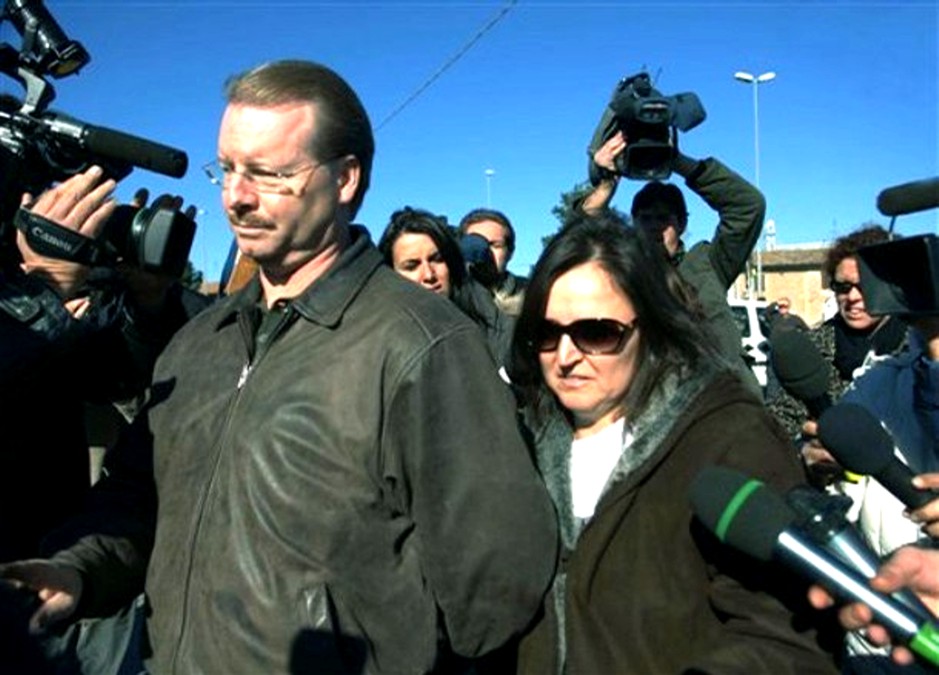
The following is a personal observation on the state of play of the Seattle driven PR campaign and resultant Media involvement in the first appeal stage of dear Meredith’s murder trial.
Amanda Knox and Raffaele Sollecito were unanimously convicted of involvement in her barbaric torture and murder by the Court in Perugia in December 2009.
As far as I am aware nether the Court of Assisi or the Kercher family (or their agents) are actively engaged in presenting any PR information whatsoever on the part of the ongoing trial process to any media outlets anywhere.
On the other hand, we know for a fact that the Knox/Mellas faction have engaged in and continue to use the services of a national brand public relations firm to “put their spin “ of events into the public arena.
Their areas of focus have primarily been the USA electronic and print media with secondary efforts attempted with the UK media.
What the USA and UK public are witnessing in the present media output therefore is the culmination of the intense and bought (paid for if you like) “reporting” solely on behalf of and in the interest of Amanda Knox (they are not bothered for now to include that waste of media space Raffaele).
The USA and UK media have little to zero interest in this case as a newsworthy story and consequently will not get off their seats to report on it. It was a seven day wonder that dragged on too long and now no longer sells newspapers.
They will however accept handouts in the present form of biased and prejudiced propaganda press releases from the Knox/Mellas camp and print it as “reporting”. It fills column inches and can be “tarted up” to a degree of sensationalism for occasional use and increased circulation.
The PR campaign would have us believe that the AK/RS appeals submissions have debunked the existing evidence and discredited the witnesses.
This of course is what they are paid to say even when it is not the case. It may have an agreeable ring to it for the accused supporters but holds little sway with the eight person judicial adjudicating panel comprising two professional Judges and six lay volunteers..
It is the job of the defence legal team to say that they have turned a corner in terms of exonerating their clients. However turning a corner is not such a big deal when you are right bang in the middle of a maze.
The sheer volume of evidence that exists and the undeniable interconnections that links it all to AK & RS constitutes that maze; someone should remind their supporters that you can turn many corners in a maze and still not get out.
It must be remembered that holding this appeal is an automatic function under the Italian Judicial system.
The PR campaign would (wrongfully) have its audience believe that this appeal is happening as a result of faults in the prosecution case uncovered during the first trial; because this is the practice in the USA and UK where an appeal would only be granted if there were discernible strong grounds and on merit.
The spin is capitalising on the (wrongful) perception by the media and the public in the USA and UK that there must be strong grounds for an appeal.
This is not the case here. It is an automatic appeal.
The prosecution case was solid and the conviction was unanimous in the first trial. Nothing has changed. The prosecution case is still the same and the outcome is therefore likely to be the same.
Make no mistake; the Judges involved in the appeal process are not fickle or weak-minded individuals that are easily swayed by media spin, insults or bullying attempts. Neither are they bought or in the pocket of the Knox/Mellas PR apparatus.
It is likely they are unaware of much or indeed any of the “spin” that is being generated by the Knox/Mellas faction in the media outlets in the USA and UK.
Most likely they have real lives to get on with themselves and see (rightfully) this appeal trial as simply another task they will perform correctly out of hundreds of others they come across in the course of their career; it is no more or no less important than every other case they have or will work on.
This is likely the same scenario that the Judges in the initial trial undertook when they carried out their duty in a fair and honest fashion.
They came to a unanimous decision based entirely on the evidence presented to them that Amanda Knox and Raffaele Sollecito were guilty of compliance in the murder of dear Meredith. The same can be stated for every Professional judge that sat on every AK&RS court appearance since dear Meredith’s murder.
Just because a blog or PR fed news outlet in the USA or the UK proclaims that the tide is turning in favour of the accused doesn’t mean that the Judges in Italy are even aware that there is a tide there in the first place at all; not to mention even considering that it is turning.
These Judges by their very nature are genuine and conscientious people.
They will not favour PR fed media coverage and disregard the evidence presented before them in court. And they certainly are not in anyone’s pockets. They will do their duty in the same upright manner and with the same exemplary scruples as was carried out by the Judges in the first trial.
Based on the case presented in the first trial and now to be re-presented in the appeal (and once you remove the PR hype) there is every reason to believe the convictions of AK&RS will stand. This is how I see this second trial going.
Rest in Peace dear Meredith.
Monday, November 29, 2010
Explaining The Massei Report: The Timeline For Events Before, During, And After The Night #1
Posted by catnip
The Masssei Timeline To Midnight 1 Nov
These two posts list all of the events precisely timed in the Massei Report. Page numbers shown in brackets are those in the original Italian version.
This timeline will be reposted over on the TJMK Massei Report summaries and highlights page as we populate that page further starting this week.
There are plenty of mentions of imprecise occasions and general time periods, such as when Rudy told Giorgio Cocciaretto about liking Amanda (p26) or when lawyer Palazzoli found out their stolen computer had been recovered in Milan (p33), but they are not listed here.
nts_before_during_2/”>Post #2
Please click here for more
Friday, November 12, 2010
Report Students Studying Abroad on Average Double Or Triple Their Alcoholic Intake
Posted by Peter Quennell
American embassies and other nations’ embassies abroad get to hear of hundreds of cases a year of students who got in over their heads.
In the past couple of years, there have been TWO notorious murders by foreign students in Florence alone. Florence is about one hour’s drive north of Perugia. The embassy simply shrugged and moved on as Italian justice worked its careful process through.
Both perps happened to be American, and both were high. There were no cries in those cases of anti-Americanism. Howvever, there was some troubled talk in Italy of the excesses foreign students go to.
And a lot of tightening up by the colleges who send a lot of students abroad, including the University of Washington (Amanda Knox’s college) and Pepperdine University (Steve Moore’s former college - this helped to seal his firing.)
Amanda Knox is one of the rare ones who shrugged off all home-college supervision, presumably with the okay of her parents. Meredith was closely watched over by the Erasmus scheme, which sadly did not save her life.
Now the University of Southern California’s student newspaper carries this report on one root cause of students facing foreign judges.
Students traveling abroad can keep glass half full
By Kelsey Clark of the Daily Trojan
According to researchers at the University of Washington, American college students who study abroad are likely to increase “” even triple “” their alcohol consumption while traveling internationally.
Students over the age of 21 doubled their intake of alcohol from an average of four drinks per week on campus to eight drinks per week abroad, according to a study published in the October issue of Psychology of Addictive Behaviors. The overall increase in surveyed students’ alcohol consumption was 105 percent, while those underage students tripled their drinking with an increased consumption of 170 percent….
By consuming alcohol in excess, particularly in an unfamiliar country, the risks for students are greater than those traditionally associated with a night of drinking at USC.
Though instances of injury, crime and sexual abuse do occur as a result of binge drinking at USC, such severe ramifications are comparatively rare within the university’s party culture. Some of the more prevalent woes are students who slept through class because of a hangover or ruined a cell phone by jumping in a pool.
But students who travel abroad must take additional precautions as the heightened risks include becoming lost, getting pick-pocketed or otherwise taken advantage of.
And of course bumping some poor innocent person off.

